

I spent the spring semester of 2009 studying abroad in Britain while working on my doctoral dissertation, a topic that I've also written about here in the Travel section on my website. One of the things that I wanted to do during this semester was to travel to other nearby locations in Europe, and I used this time to take trips to new places that I hadn't visited before in Sweden and Scotland and Germany and Italy. I was also able to visit one location that I had already seen on a previous trip to Europe: the city of Paris. I had traveled to Paris ten years earlier in 1999, on a school trip between my junior and senior years of high school. That trip lasted for a little over a week and it was my first time traveling overseas. I was able to go together with my best friend Scott and we had a total blast seeing the famous sights in the French capital. That trip also featured some shockingly poor chaperoning from the adults on the school-backed venture; we had breakfast as a group together at 8:00 AM in the morning and were told to meet up again in the evening at a certain location for dinner, then left totally unsupervised to walk around the city for the rest of the day, as 16 and 17 year old kids who had never before traveled internationally. Scott and I were responsible students and handled this with no problems, but there was one teenage girl who had her tongue pierced and it's a miracle that no one was injured or kidnapped. Remember that no one had mobile phones in 1999 and students were being left completely on their own in a foreign city that spoke a different language. I still can't believe that that actually happened!
By the time of this trip in 2009, I was ten years older and a lot more seasoned when it came to international travel. I had been living alone for half a dozen years following college graduation and had furthermore been residing in London for the previous three months while researching in the British Library. This trip took place on the week prior to Easter (which fell on April 12th in 2009) and I would be joined by my parents, who had flown out to meet me in London for a few days before the three of us traveled together to Paris. My dad had visited Paris once before when he was in college in the early 1970s and my mom had never been to France at all. I had also taken several years of French in school, enough to have a solid level of reading comprehension if far short of speaking fluency, while my mom had taken Spanish and my dad had taken, uh, Latin. Therefore I was in the position of being the local expert on this trip even though I had spent all of seven or eight days in France in my life to that point. But I was very familiar with the geography of where things were located in Paris, and I knew enough to be able to read all the signs in the rare case that we'd come across someone who didn't already speak English. That would help even though Paris is a very easy city to travel within for English-speakers.


We left from London's St Pancras station (right next to where I was researching in the British Library) and took the Eurostar train over to Paris. This involved traveling through the Channel Tunnel which was a lot more interesting in theory than it was in practice. One minute we were speeding through the green countryside of southern England and then the next minute we were inside a tunnel where it was dark and there wasn't much of anything to see. The travel by rail was smooth and fast, taking a little over two hours to travel between the two cities. We arrived at the Gare du Nord station in Paris and hopped onto the metro to take us to our hotel, which was located in the 1st arrondissement a couple of blocks north of the Louvre. (It was very close to the Fontaine De Theatre Francais if anyone knows where that is.)

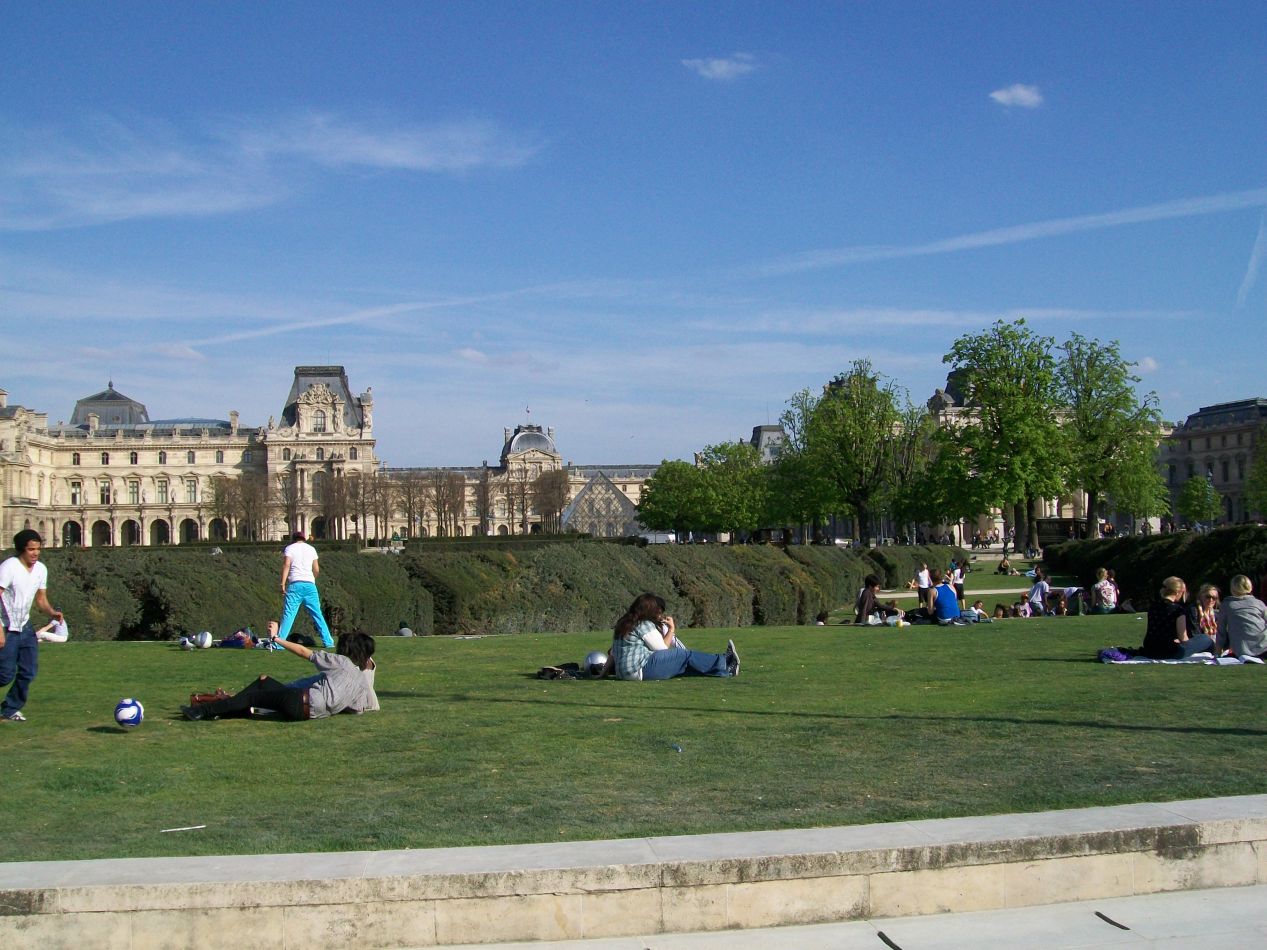


I suggested that a good first activity to do in Paris would be to stroll from our starting point near the Louvre through the Tuileries Gardens and then up the famous Champs-Élysées towards the Arc de Triomphe. This is one of the most famous walks in the world and it's an easy distance to cover at about 1.5 miles / 2.5 kilometers. We started out at the western edge of the Louvre complex, near the location of the Carrousel Arc de Triomphe. This bite-sized version of the Arc de Triomphe was also built by Napoleon in 1806 to commemorate his sweeping victories that took place the previous year at Ulm and Austerlitz. The nearby Tuileries Gardens were formerly part of the Louvre complex where an extention of the palace once stood, only to be damaged severely in the 1848 revolutions and then destroyed entirely by the Paris Commune in 1871. The ruins were eventually turned into the public park that we walked through as we headed towards the Champs-Élysées. It was a perfect spring day and there were lots of people outside enjoying the fine weather. It was easy to forget that the outdoor square now containing fountains and the Luxor Obelisk was the Place de la Concorde, the site of mass public executions during the French Revolution, including the spot where King Louis XVI was killed.

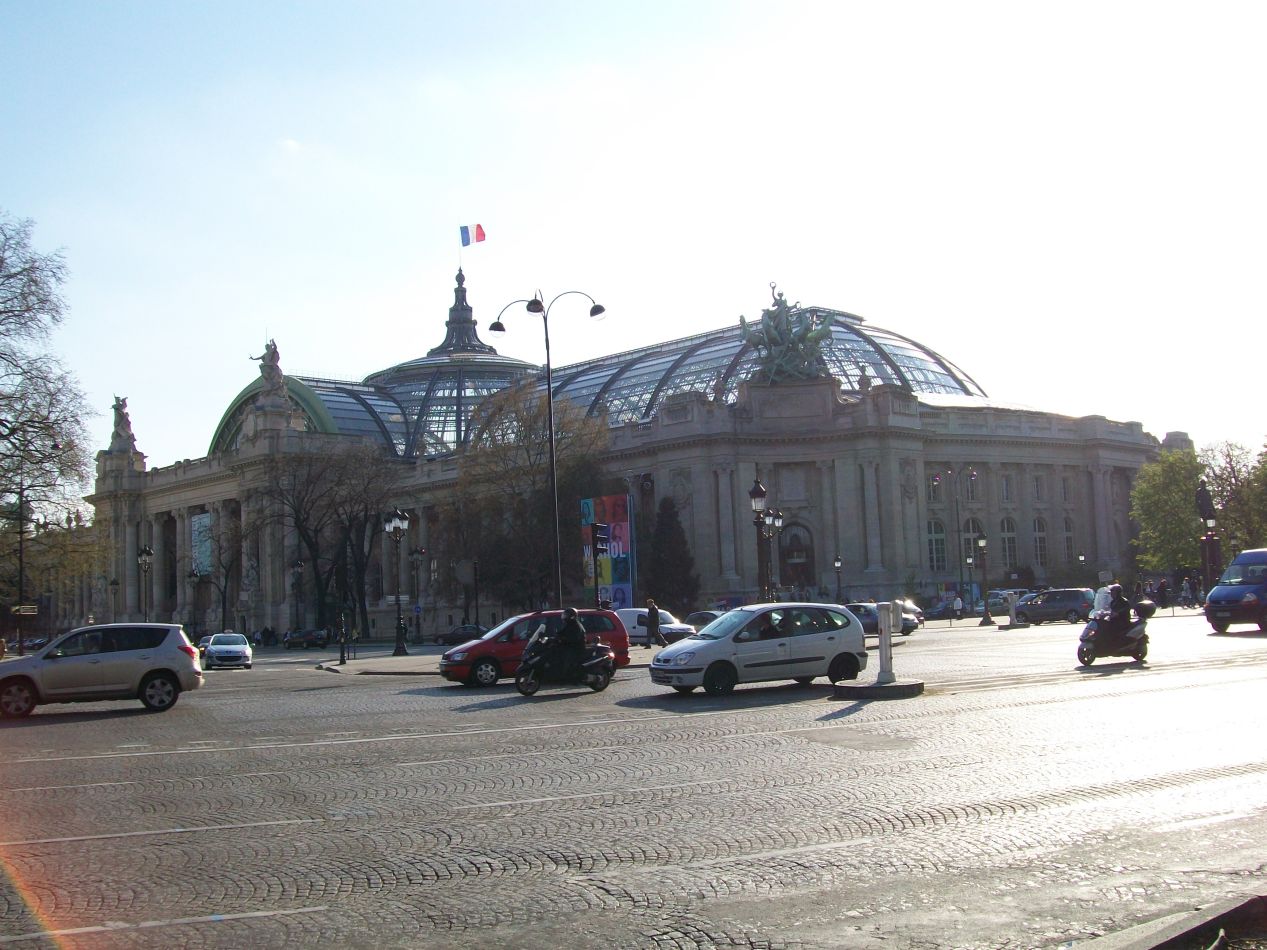


From the Place de la Concorde, the Champs-Élysées runs straight as an arrow to the northwest towards the Arc de Triomphe. This is a major shopping corridor and particularly in the realm of upscale fashion and luxury goods. I'm looking at the current stores listed on Google Maps as I type this, and I'm seeing names like Chanel and Sephora and Louis Vuitton in addition to giant retail stores from Nike and Disney and the like. For whatever reason I didn't take any pictures of the retailers on this trip, therefore not providing readers of this page with an accurate impression of what the Champs-Élysées looks like, and the next images that I have come from the Arc de Triomphe itself. This was also constructed by Napoleon as a triumphal arch to commemorate his military victories, with the Wikipedia entry stating that "its iconographic program pits heroically nude French youths against bearded Germanic warriors in chain mail." Symbolism was apparently a bit different in the early 19th century. Construction on the Arc du Triomphe was repeatedly halted due to lack of funds, along with minor other issues like Napoleon getting thrown out of power by a coalition of European great powers, and the monument wasn't finished until 1836. The overall height of the monument is 50 meters / 165 feet tall and it also houses France's tomb of the unknown soldier from World War I.

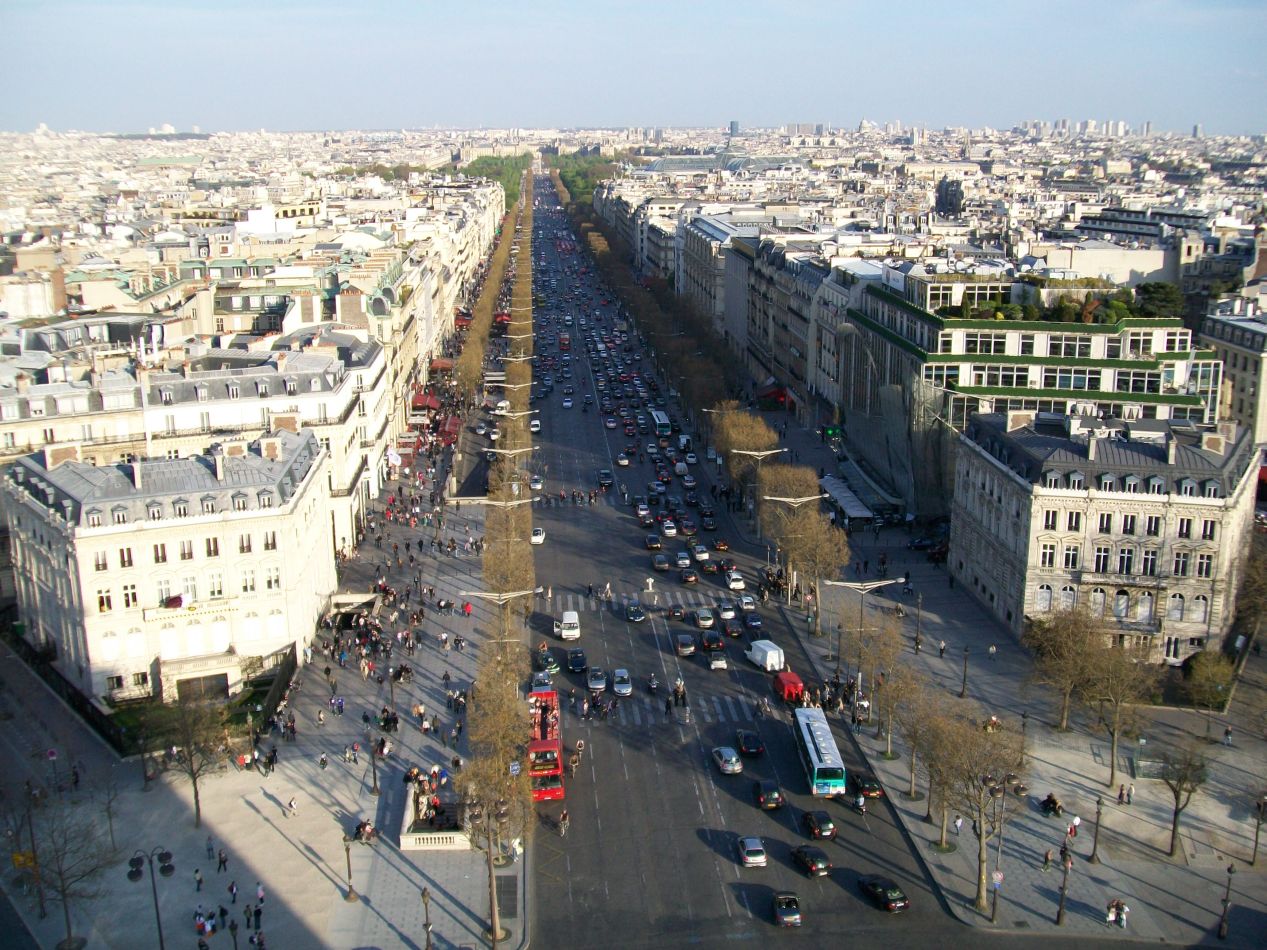


The Arc de Triomphe sits in the middle of Place de l'Étoile (place of the star), a unique feature of the layout of the city in which twelve different avenues meet together in one large circle. I've always thought that this is the world's craziest traffic circle and never, ever want to have to drive through it. Pedestrians access the monument by going underground through a short tunnel to avoid ever needing to cross the encircling traffic. As bad as Place de l'Étoile might be for driving, it also creates a striking visual image from the center of the design, as a dozen separate avenues radiate outwards in all of the compass directions. Visitors can climb up to the top of the arch for a fee, and this is one of the best places to get views of Paris. Even though the Arc de Triomphe is not terribly tall, the city has strict zoning ordinances that keep any skyscrapers from being constructed in the downtown and allow for an uninterrupted view in every direction. The pictures above look, in order: north towards Sacré-Coeur, east back towards the Louvre down the Champs-Élysées, south towards the Eiffel Tower, and west towards the even higher Grande Arche de la Defense. I had visited that 100 meter tall steel archway on my previous trip to Paris but wouldn't be heading back to Defense on this trip.

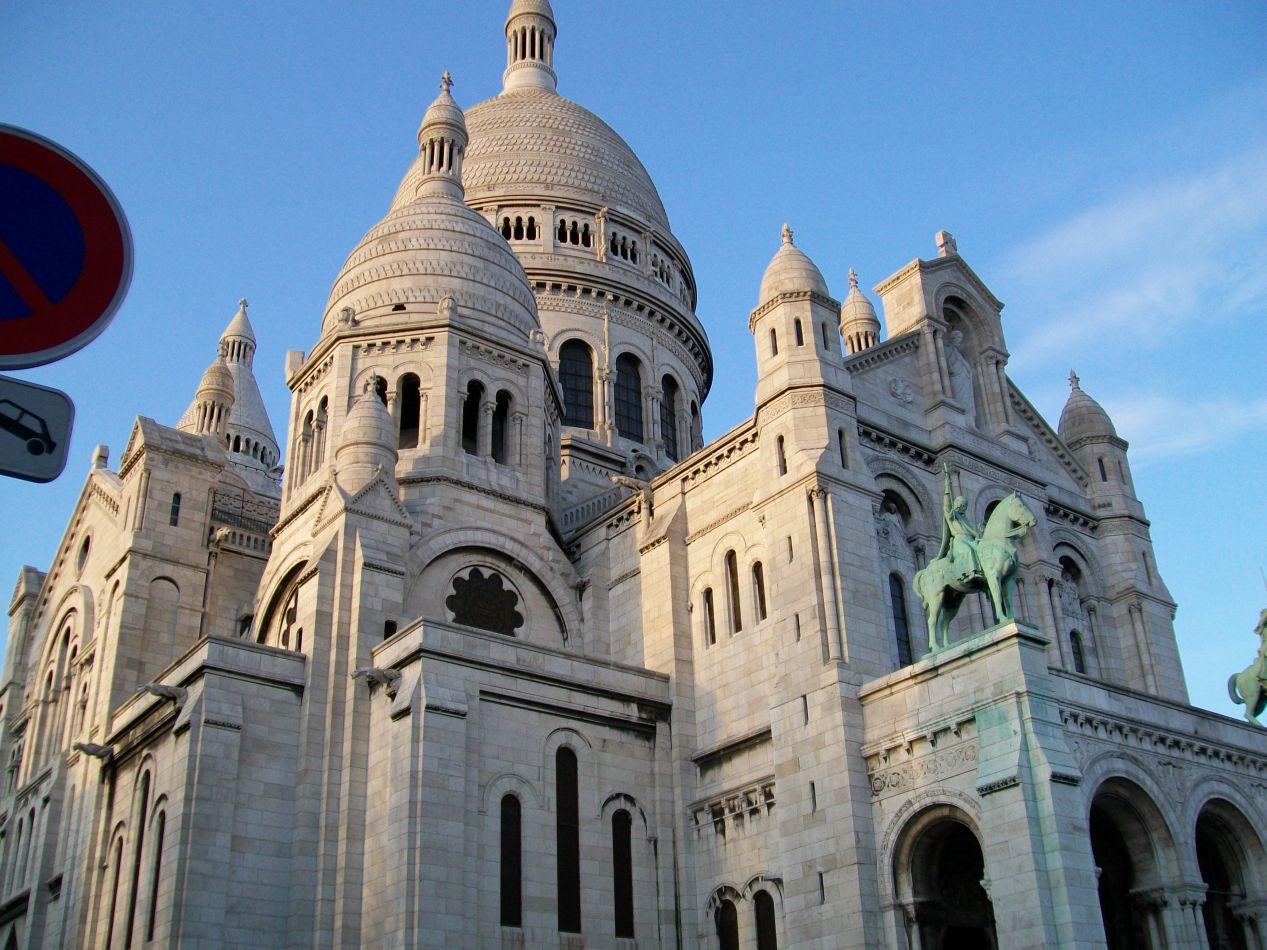


It was already late afternoon by this point, and we decided to use the remainder of the day to visit Sacré-Coeur and the Montmartre neighborhood of Paris. This area is a pretty good distance north from the rest of the downtown in Paris and it made sense to visit it when we didn't have time enough to go anywhere else. The Montmartre district holds the highest elevation in the city and has been known historically as a neighborhood where artistic types gathered during the late 19th and early 20th centuries. This is where the famous Moulin Rouge nightclub was founded in 1889, although the current building is a reconstruction as the original theatre burned down in 1915. We walked past the outside of the Moulin Rouge without going inside.
Sacré-Coeur de Paris was the attraction that we had come to see. This basilica was constructed following France's defeat in the Franco-Prussian War of 1870-1871, and although today it has come to be viewed as a symbol of national reconciliation following the end of the war, it was originally intended as an attempt by French conservatives to attone for "a century of moral decline" that culminated in the Paris Commune. Sacré-Coeur was built on top of the tallest hill in the city out of white stone bricks in an unusual Romano-Byzantine style of architecture. The narrow domes used on Sacré-Coeur tend to be more associated with Greek or even Islamic religious architecture more so than the Gothic and Baroque designs elsewhere in Paris. This helps to make the basilica stand out from the rest of the churches in the city, and it's one of my favorite churches to visit even though they don't allow interior photography for some reason. (Here's a picture of the interior from elsewhere on the Internet.) The views from the steps of Sacré-Coeur looking out over the rest of the city are also pretty spectacular. We had dinner afterwards at one of the restaurants at the nearby cobblestone-lined Place du Tertre, capping off the end to a wonderful first day.

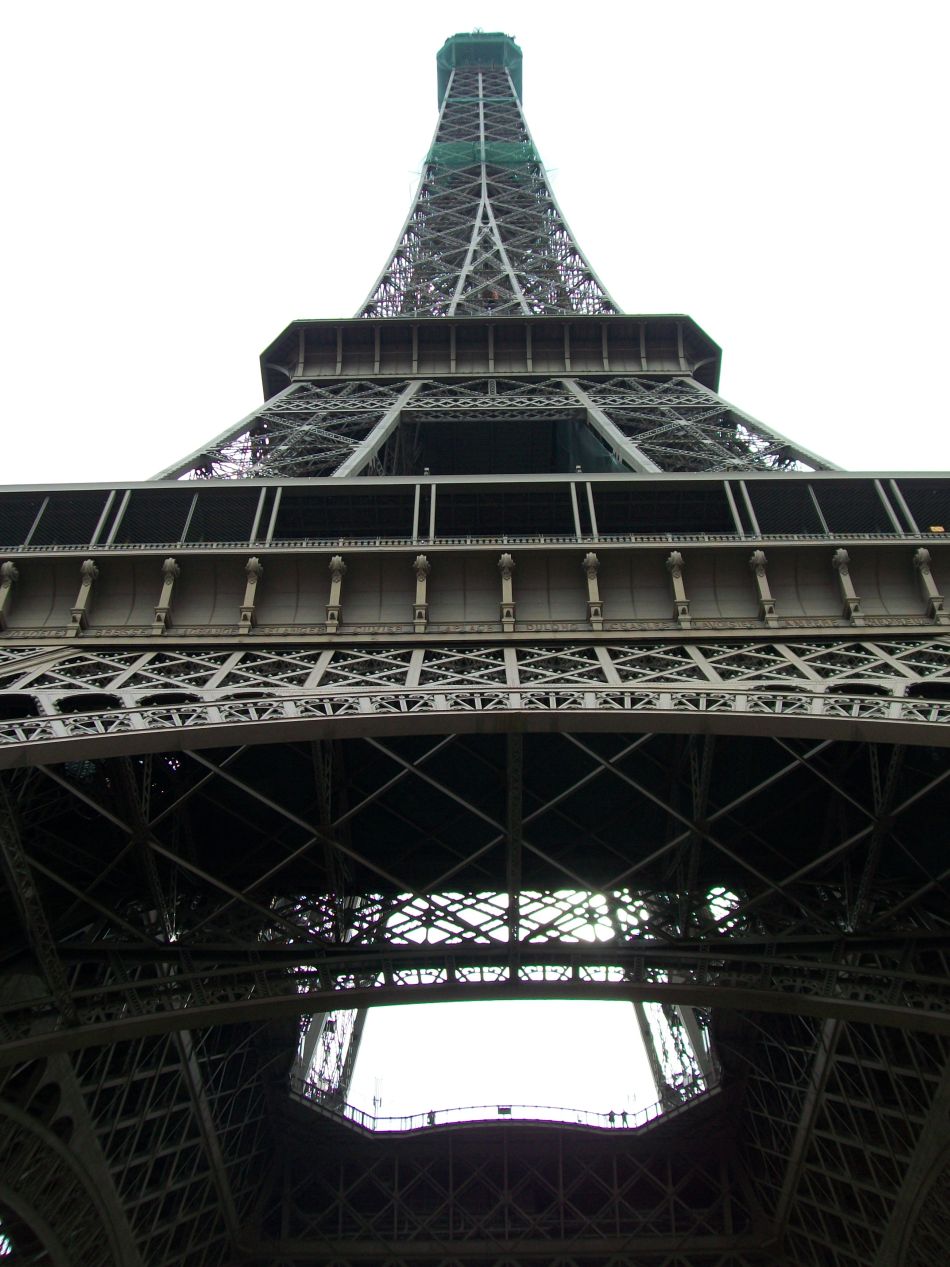


The next morning dawned under cloudy skies, nowhere near as nice as the previous day but fortunately not raining. We decided to start the morning by visiting the Eiffel Tower, the most famous landmark in the city of Paris. Designed and named after French engineer Gustave Eiffel, the tower was originally built for use at the 1889 World's Fair and intended to be a temporary exhibit, only to prove popular enough (and useful enough as a radio and television broadcasting tower) that it became a permanent part of the city. It's always felt a bit strange to me that the Eiffel Tower became the internationally renowned symbol of Paris rather than the Louvre or Notre Dame or the Arc de Triomphe, and it's fairly low on my list of favorite attractions in the city. Nevertheless, visiting the Eiffel Tower is a mandatory part of any trip to Paris and we headed there early in the day before it became too crowded. Near the iron structure, the color of the Eiffel Tower is revealed to be different shades of brown rather than the black that it can appear at a distance. We rode up to the second visitor level on the cable cars attached to the tower, which actually run up the sides of its legs and present a dizzying view while traveling upwards. The entire Eiffel Tower is a gigantic form of interconnected iron lattices, and it can be discomforting to realize you can see right through the thing while standing hundreds of feet in the air.

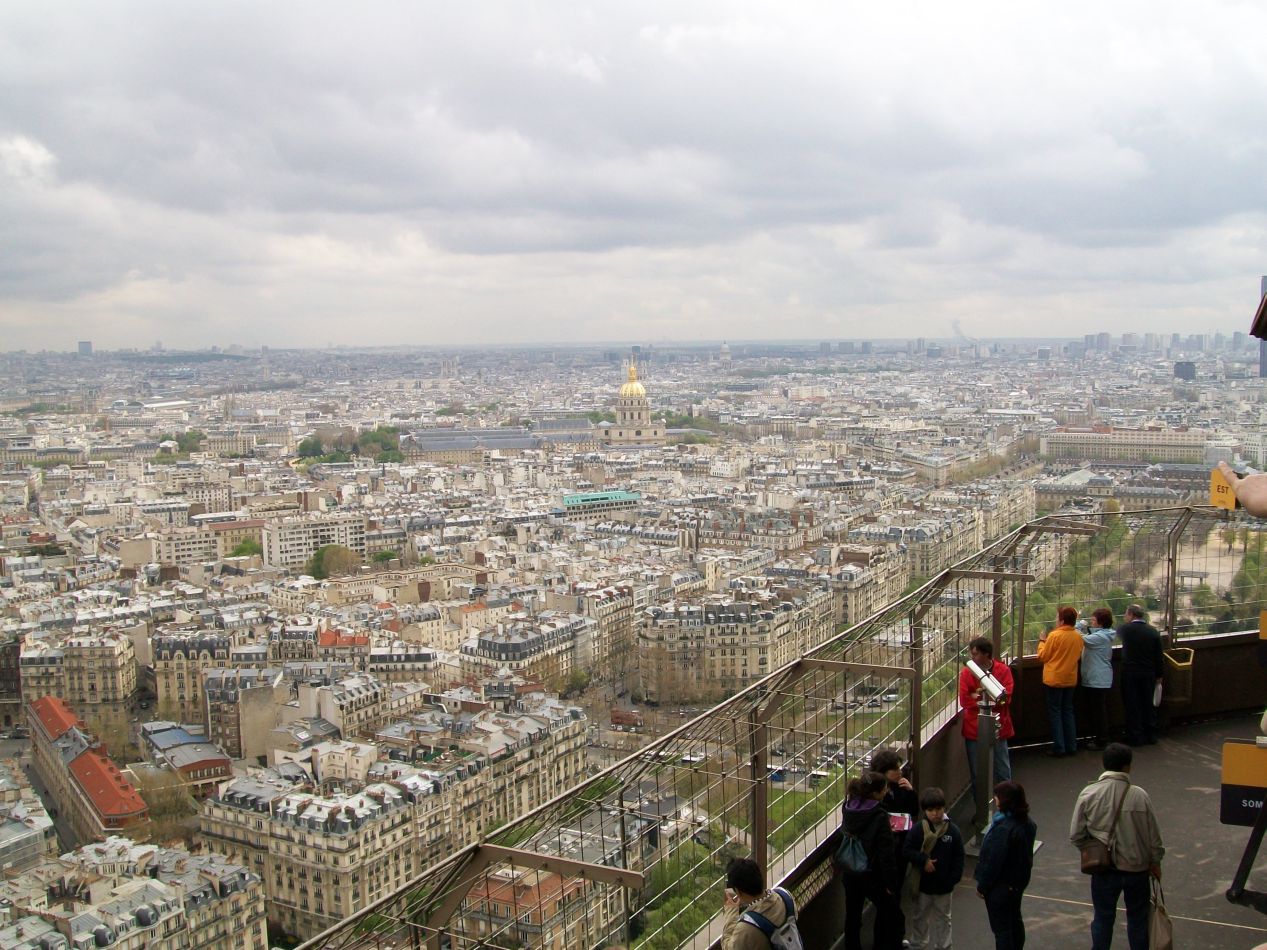


The Eiffel Tower naturally provides excellent views overlooking the rest of the city. These were taken from the second floor a little bit less than halfway up the tower, and there's a final viewing platform up near the pinnacle of the tower which we did not visit on this trip. The Eiffel Tower is situated on the southern side of the Seine River (the Left Bank or La Rive Gauche), and we could look off into the distance to spot the domes of Sacré-Coeur far away to the north as well as the closer golden dome of Les Invalides where we were headed next. Immediately across the river to the northwest of the Eiffel Tower were the Trocadéro Gardens and the Palais de Chaillot museum, the spot used by most television broadcasts that have the tower in the background. (Whenever there's an international soccer match in Paris, this is where the TV studios place their pre-match and post-match sets.) In the other direction to the southeast was the Champ de Mars, a large public park formerly used for marching and drilling by French soldiers. It was early enough in the day that the tour buses were only beginning to roll in, and the Champ de Mars was lightly crowded with visitors heading to the tower.

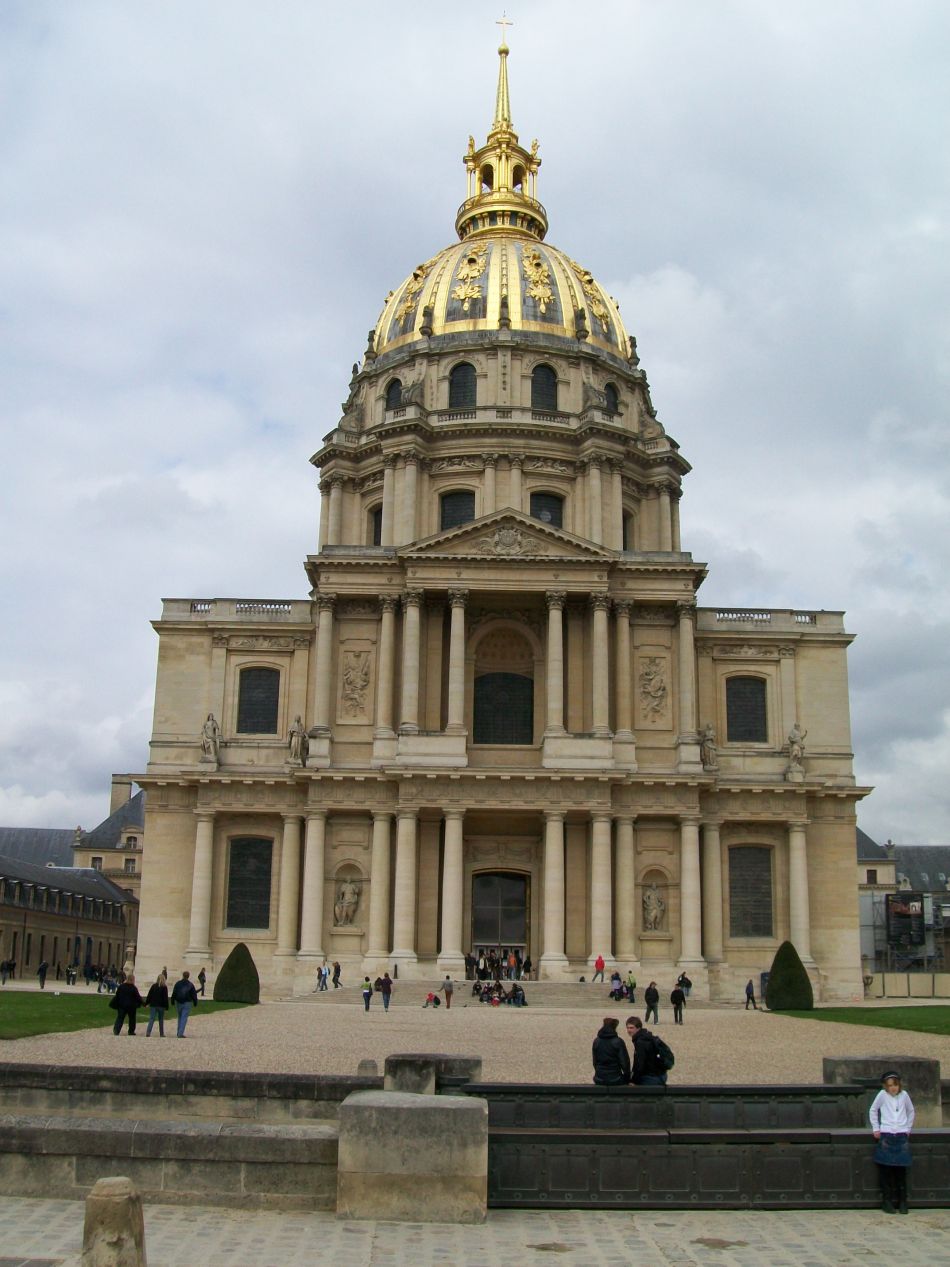


We walked down the stairs from the second floor viewing platform of the Eiffel Tower, which was a lot more interesting than taking the cable car again, and then made our way over to the domed entrance of Les Invalides. As the name suggests, this was originally a hospital and a retirement home for war veterans before being converted in more recent years into a museum dedicated to the military history of France. The building was constructed during the reign of King Louis XIV and completed in 1676, with the golden dome of its veterans chapel being the most significant feature. Today Les Invalides is best known for serving as the tomb of Napoleon, whose body was excavated and brought back to this location in the mid-19th century. There are a bunch of other French military commanders interred here as well, with Marshall Ferdinand Foch (overall Entente commander in World War I) probably being the most famous individual. The design of the building was a classic example of Baroque architecture, everything from the dome to the heavy use of gilding serving to mark its time and place of construction.

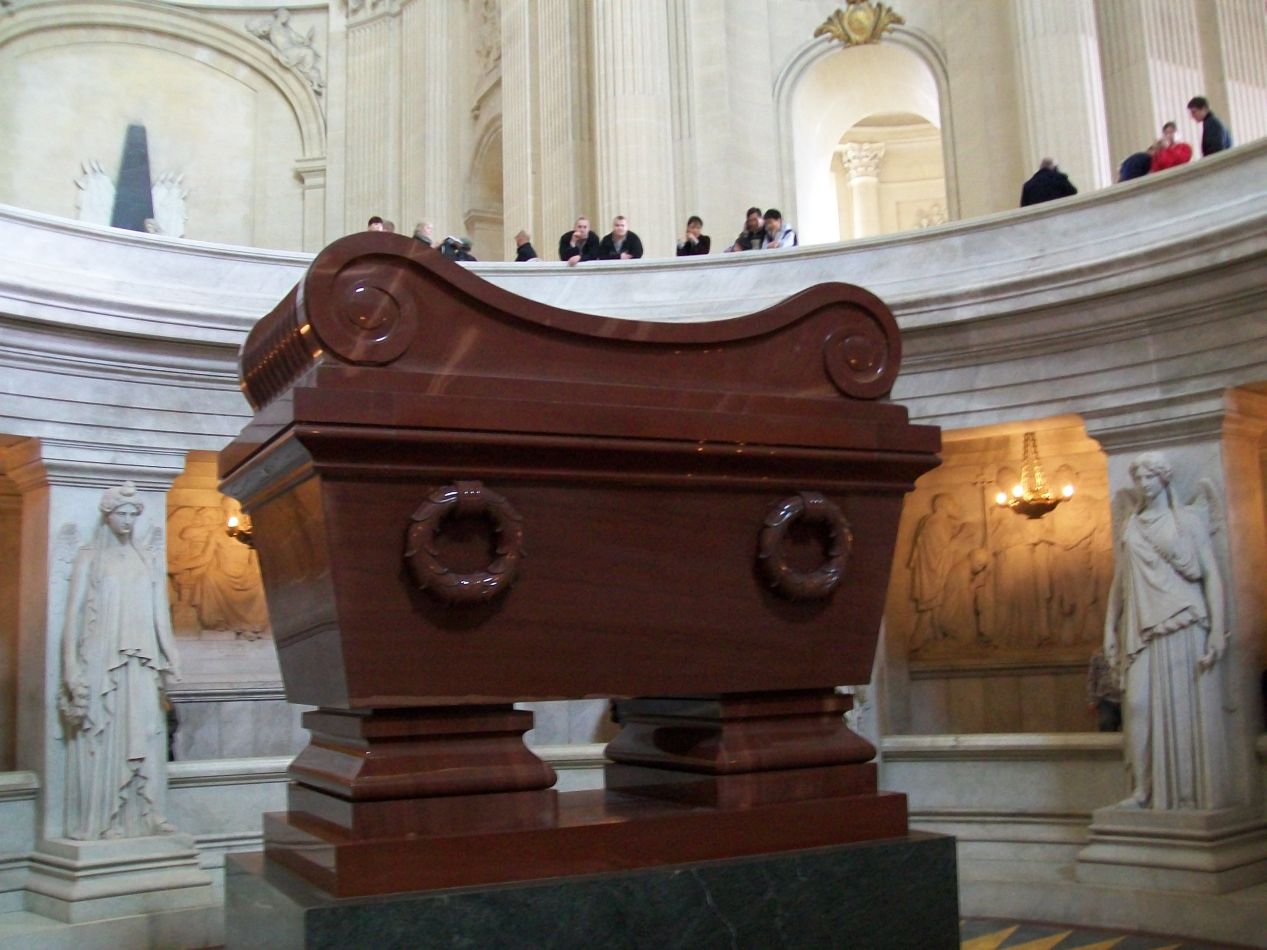


Napoleon's remains lie in a sarcophagus centered beneath the main dome at Les Invalides. The building was not originally designed to house a featured tomb of this kind, and the interior had to be completely redesigned to accomodate the former emperor over took two decades of construction. The story that they tell at Les Invalides is that everyone has to bow down to look at Napoleon's sarcophagus, and knowing Bonaparte's personality he almost certainly would have liked that gesture. There's a ton of Napoleon-themed hagiography here and visitors should be warned in advance that there's a good bit of whitewashing of the militarism during Napoleon's reign. The most beautiful part of the building is not Napoleon's tomb but rather the soldier's chapel, known formally as Saint-Louis-des-Invalides. This moderately sized church is dedicated to all of the soldiers who died serving their country, and it holds a number of foreign flags captured from enemy forces in battle up among the ceiling rafters. The atmosphere was quiet and contemplative here as compared to the throngs of tourists under the dome trying to get a look at Napoleon's tomb.

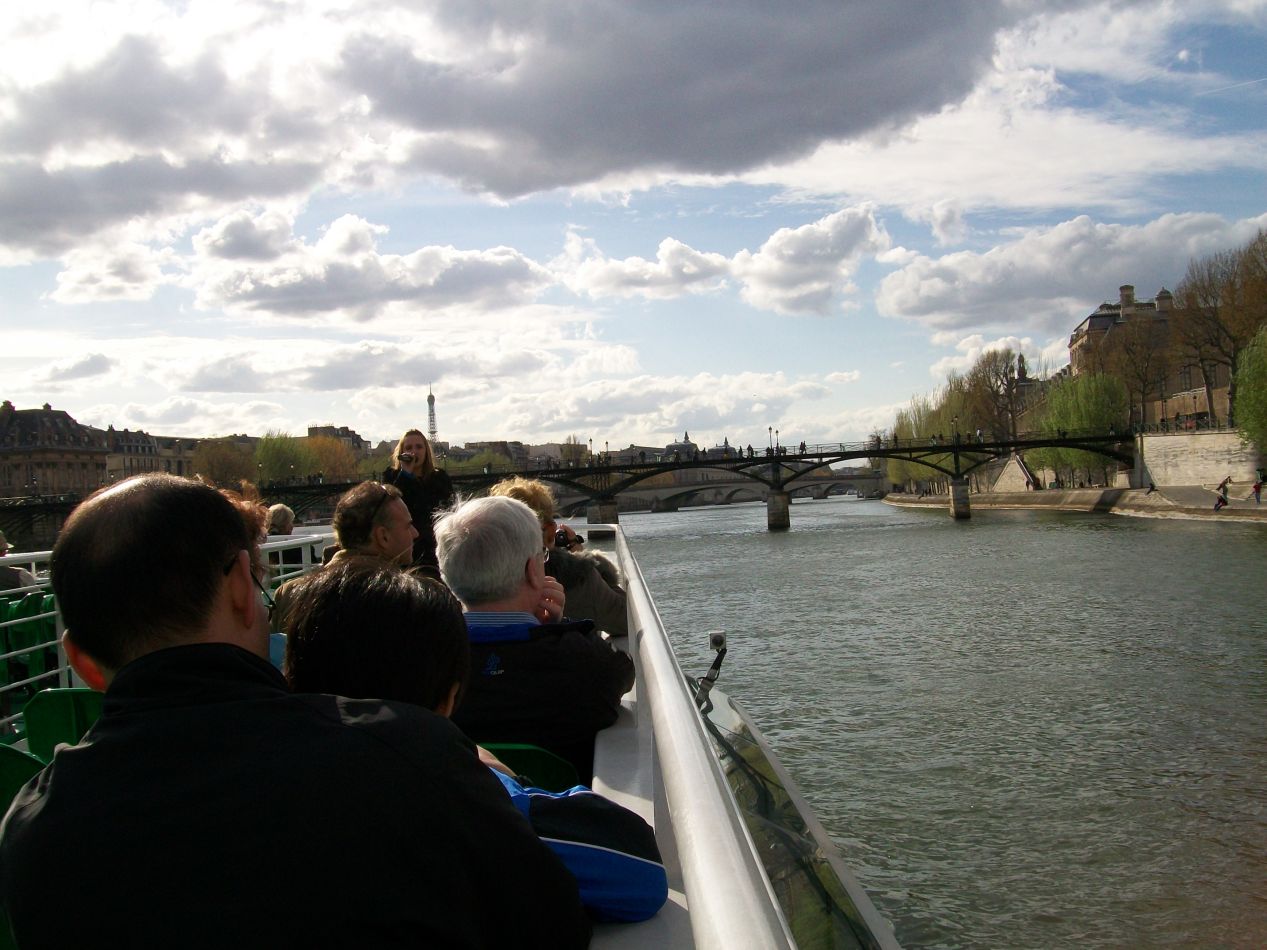


After stopping to eat lunch, we took a boat tour on the Seine to get another perspective on the city's attractions. The boat left from the western edge of the Île de la Cité, the island at the center of the city, and traveled first to the west downriver for several miles. We passed underneath a series of famed bridges, everything from the Pont des Arts to the Pont Neuf (the "New Bridge", paradoxically the oldest bridge in the city). We also passed by the Eiffel Tower again, and unfortunately the pictures that I took of the tower came out highly blurry. This was a good vantage point to see the walking paths that run alongside the river, home to vendors that sell artwork and books to passers-by. The weather was even starting to clear up and it had turned into a rather nice day.

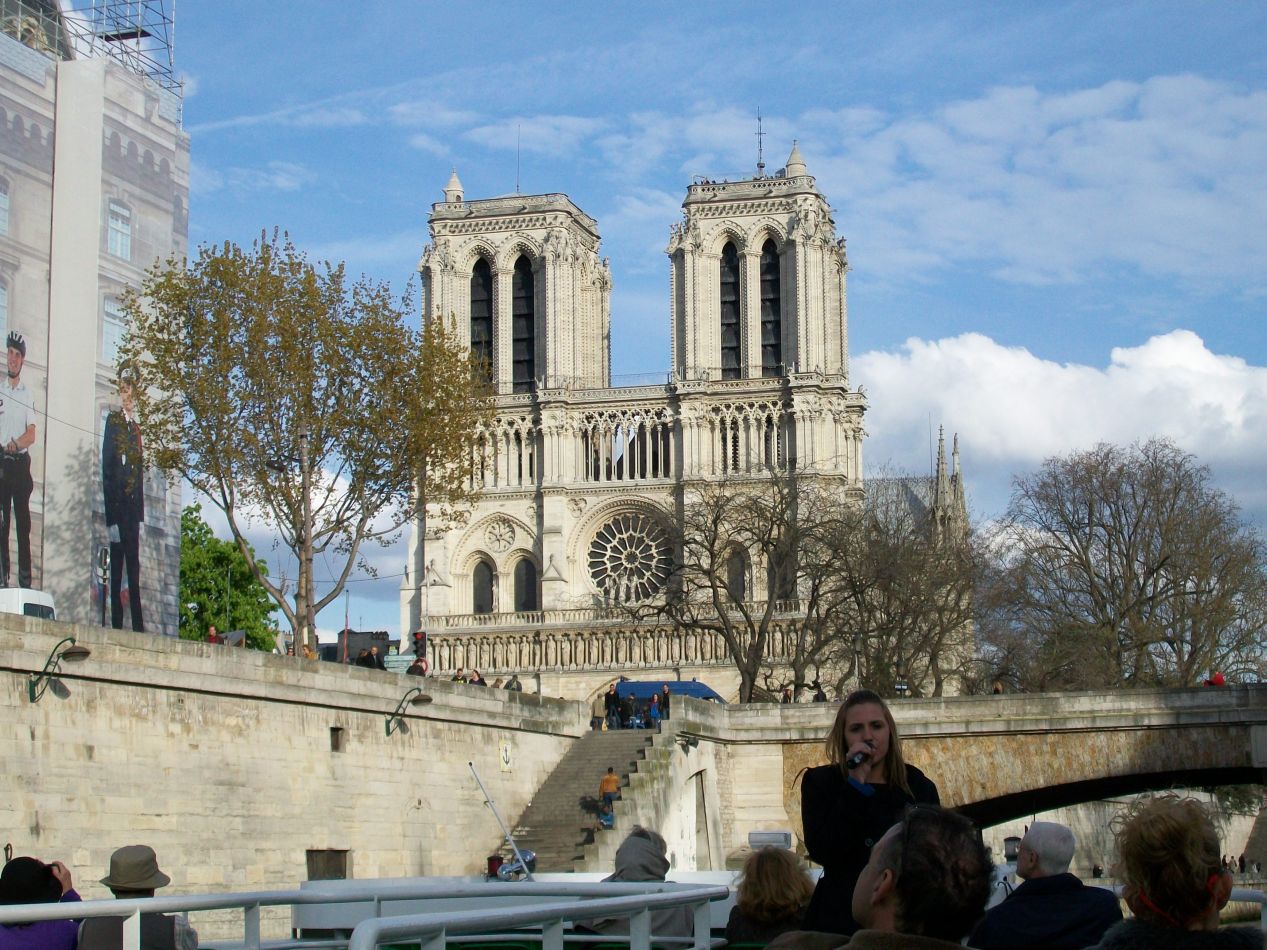


Eventually the boat turned around and began heading upriver. First it passed by the Musée d'Orsay, a former railroad station that now houses the world's foremost collection of Impressionist art. We would be heading there a little bit later on this trip. Then it reached the starting point and continued onwards, with Notre-Dame de Paris as the featured attraction to our left. Notre Dame is one of the most famous cathedrals in the world and we had excellent views of its Gothic exterior from the perspective of the river, especially the flying butresses that held up the weight of the stone walls. The view of Notre Dame from the east, looking past the Île Saint-Louis, is something that doesn't appear very often in media since it's the "back" side of the cathdral. We were planning on coming back to visit Notre Dame more properly on the next day. Overall, the boat tour was well worth the expense and a great way to take some time off of our feet while still exploring Paris.

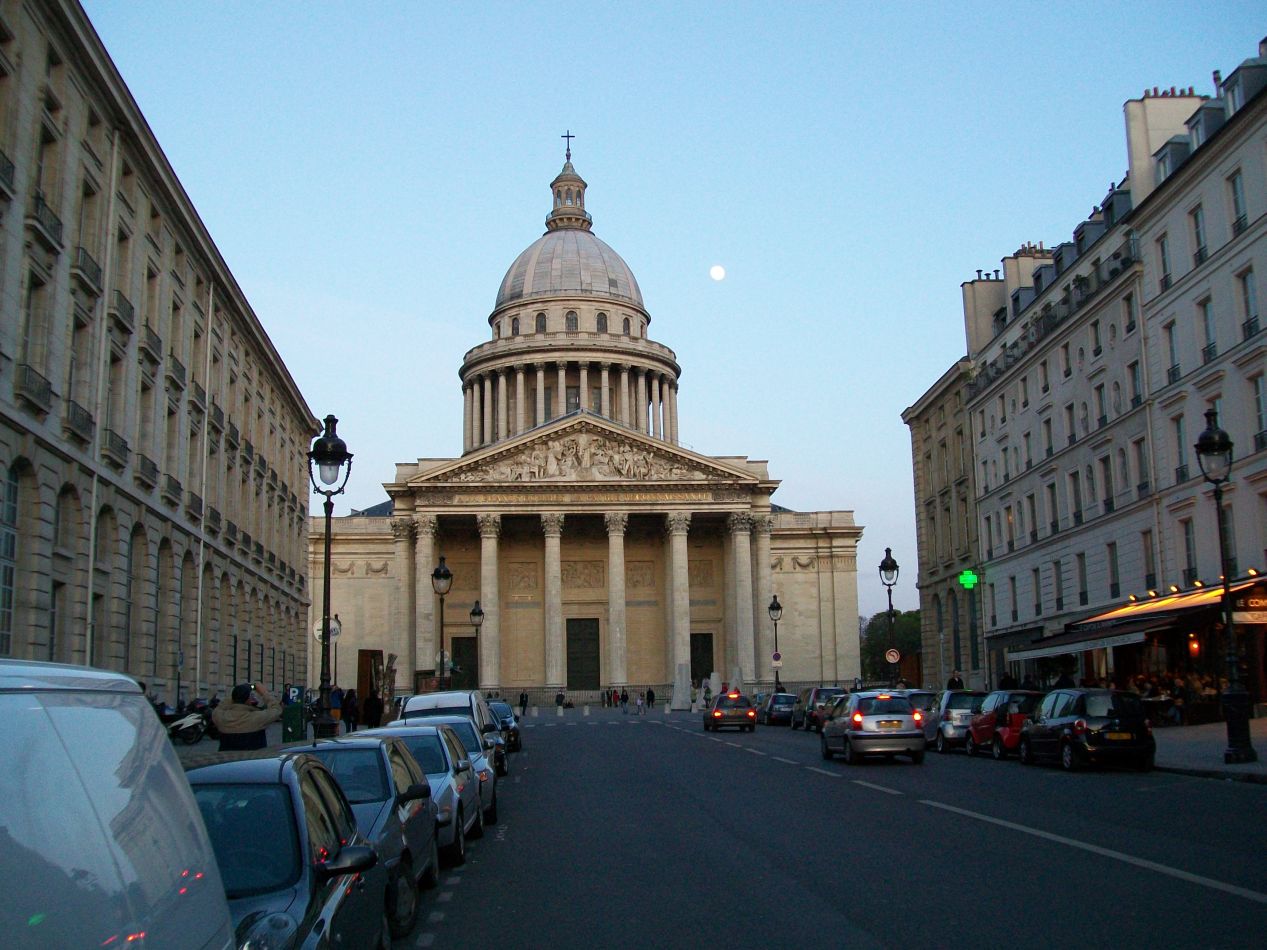


We crossed over to the Left Bank afterwards and spent some time walking through the streets of the Quartier Latin, or Latin Quarter. This is a part of the city known for its student life, artistic establishments, and restaurants, making it a natural tourist destination. We ate dinner at a place named "Le Vieux Paris" which probably wasn't particularly old, although it was located in a warren of twisting medieval streets so who knows, maybe. This same area was the home to the Panthéon, a mausoleum holding the remains of many famous French individuals, from Voltaire and Rousseau to Victor Hugo and Marie Curie. Unfortunately I had neglected to realize that the Panthéon was already closed for the day, and I led my parents on a 15 minute walk over to see a shuttered building. Whoops. This is an attraction that I need to visit on my next trip to Paris, when the place is actually open. This area was also the home to the Université Paris-Sorbonne, one of the top universities in the world and certainly the most famous French-speaking institution, as well as the Luxembourg Gardens. It was too late by now for us to spend any time in the gardens, and I snapped a picture of the Palais du Luxembourg (now the home of the French Senate) illuminated by streetlamps. It had been a long day even though we never went more than a mile away from the Seine.

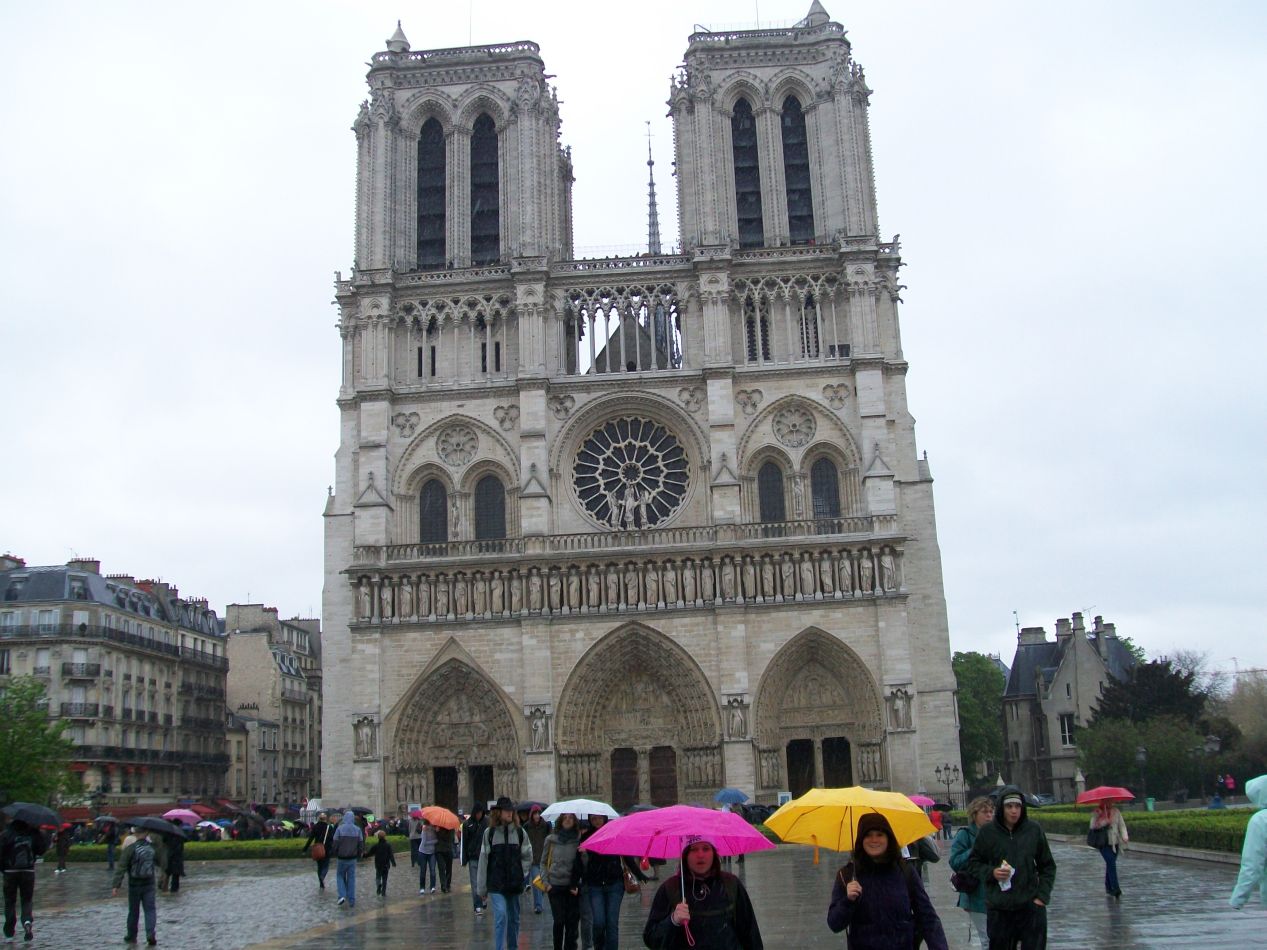


We woke up the next morning to overcast skies and a steady rain, the kind of stormclouds that produce a daylong deluge that leaves everything thoroughly soaked afterwards. We decided that this would be our "museum day" with the intention to spend as much time as possible inside to avoid the falling rain. Our first destination was the Île de la Cité, which looked particularly medieval this day when seen against the backdrop of those stormclouds. We headed for the looming spectacle of Notre Dame right as the rain began to pick up in intensity, sending us scampering for the doors. I was reminded of the scene in Victor Hugo's Notre-Dame de Paris (better known in English as The Hunchback of Notre-Dame) where the characters pound on the doors of the cathedral calling for sanctuary. There was nothing that dramatic here but it was certainly nice to get in outside of the cold and the rain.

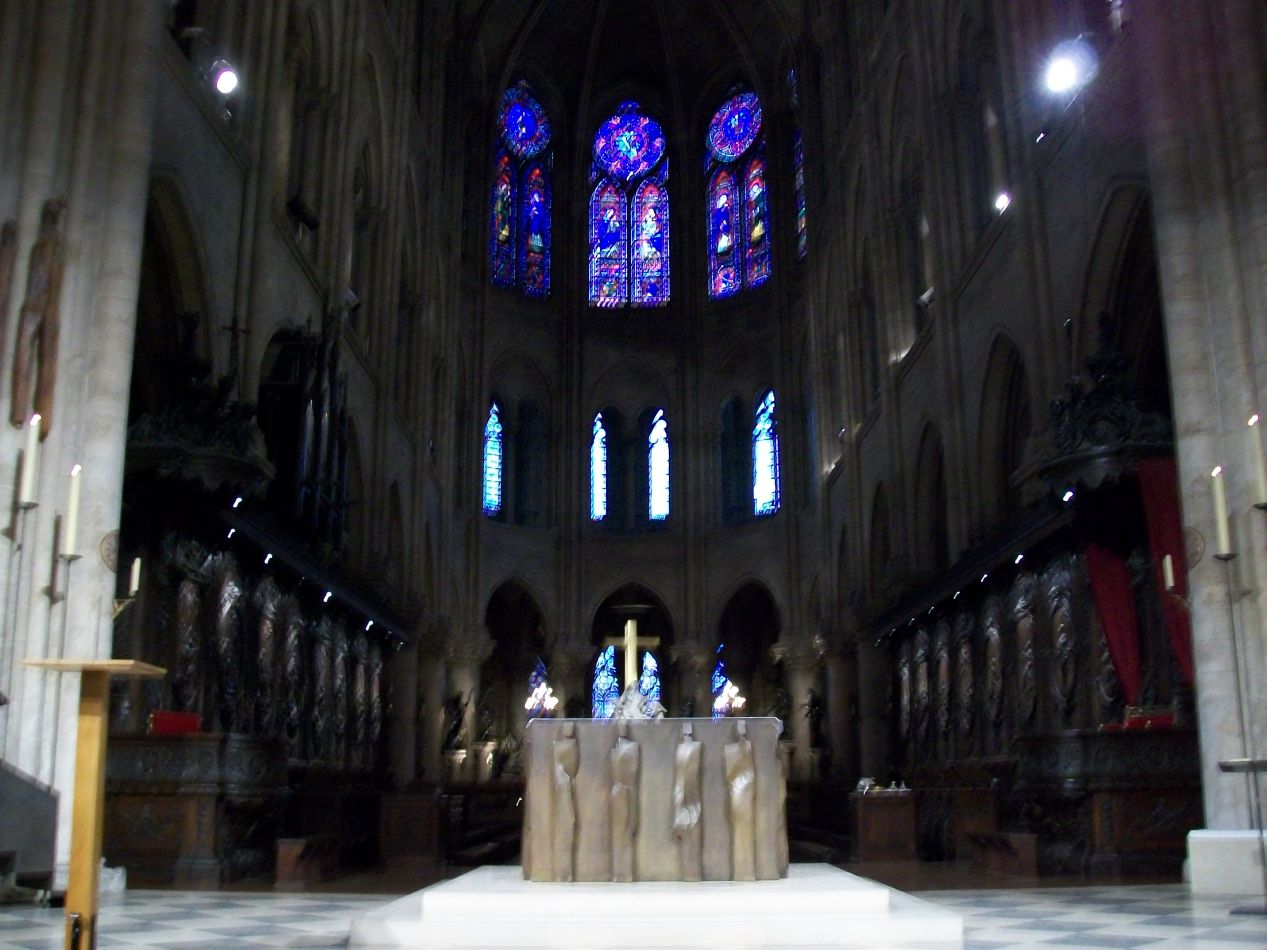


Notre-Dame de Paris is one of the world's great treasures, among the most famous and beloved works of religious architecture to be found anywhere. There's a reason why this cathedral has been a world wonder in so many different incarnations of the Civilization series. Although Notre Dame was not the first Gothic cathedral to be built, in many ways it has served as the touchstone for the design, the model to be endlessly imitated elsewhere in a thousand different variations. According to Christian tradition, Notre Dame houses some of the most sacred relics of the faith, including the Crown of Thorns and a silver of wood from the true cross. Most of the building was constructed in the 12th century and it has survived disaster after disaster over the centuries, ranging from wanton destruction of its religious imagery during the French Revolution to occupation of the city by the Nazis during World War II. This was where the infant Henry VI was crowned king of both England and France in 1431 and Napoleon was crowned as emperor in 1805. The interior has beautiful stonework and three incredible rose windows of stained glass that defy easy characterization. Unfortunately this trip took place when I still had a cheap digital camera, and all of these interior pictures came out looking like rubbish. I want to go back again to Paris just for the purpose of capturing some genuine pictures of Notre Dame. Here's what the place actually looks like in an image taken from the Internet.

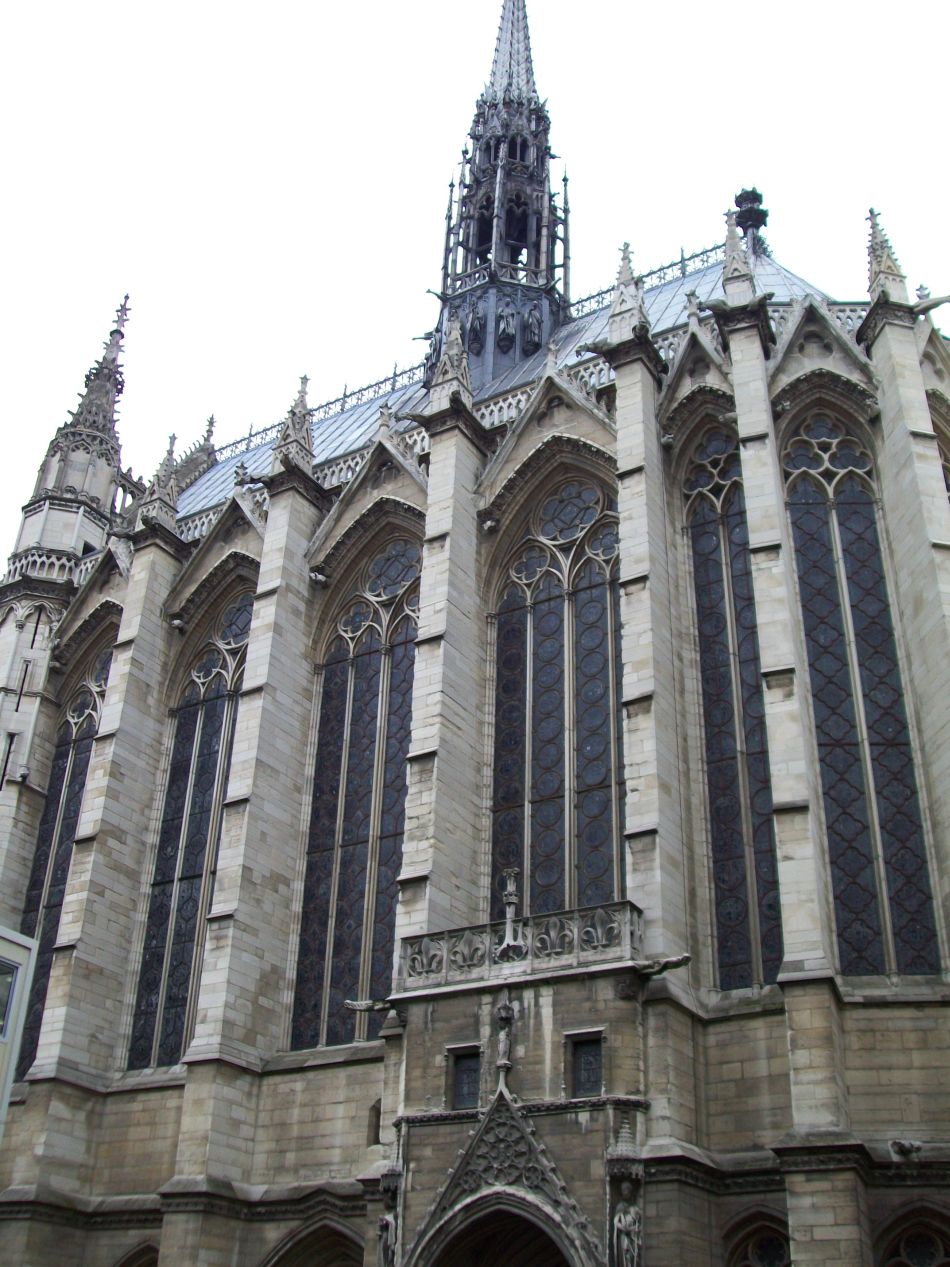


Notre Dame shares the same island with my absolute favorite church that I've ever visited, the chapel of Sainte-Chapelle. This is a much smaller church built by King Louis IX in 1248, designed to house his collection of Christian relics including the Crown of Thorns now held in Notre Dame. Sainte-Chapelle can be easy to miss since it sits inside the complex of the Palais de Justice, a series of government buildings that today holds the headquarters of the French judicial system. Sainte-Chapelle was also constructed in the same French version of the Gothic style used at Notre Dame, but it has the unusual feature of holding two different chapels, one stacked vertically on top of the other. These are pictures of the exterior and the Lower Chapel, which contains the modern gift store and looks fairly unimpressive. My school group came here on my initial trip to Paris in 1999, and as someone who had never heard of Sainte-Chapelle at the time, I was wondering what exactly we were doing here. If someone only visited the Lower Chapel, they would come away thinking that they had wasted their time.

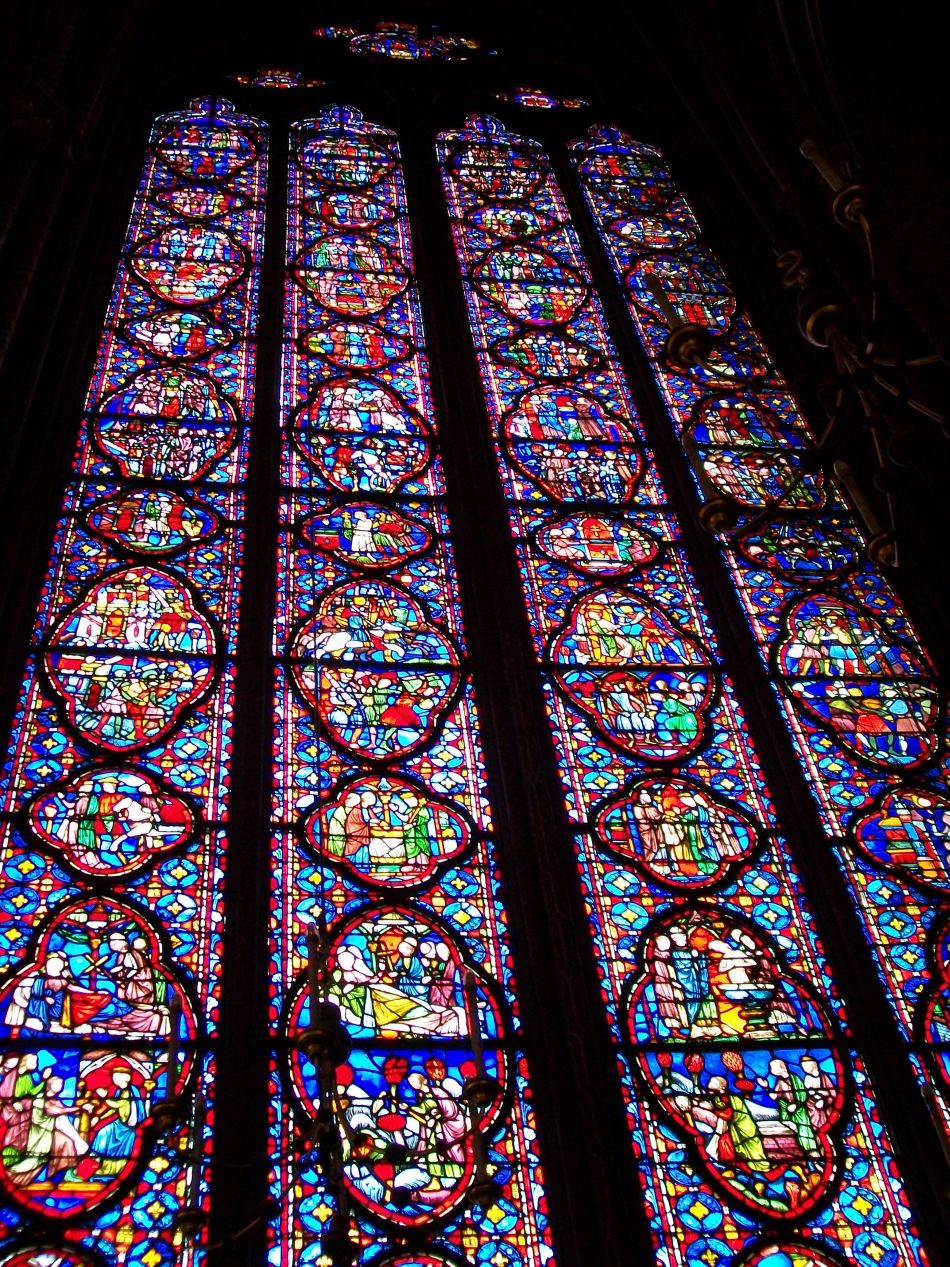


The Upper Chapel is what sets Sainte-Chapelle apart from other medieval churches. The unknown architect of Sainte-Chapelle evidently had the thought, "what would happen if we made EVERY wall a stained glass window?" and set about turning that vision into reality. The result is a dazzling display of light and color that left me speechless the first time that I saw it. Fifteen huge mid-13th-century windows make up an entire side of the chapel above the main altar, while a large rose window of more stained glass takes up the other side. The crummy pictures that I took with this camera truly do not do the place justice; here's a much better version pulled from the Internet. But even that professional photograph sells short the reality of visiting Sainte-Chapelle. The detail on the stained glass is simply incredible, all of those thousands and thousands of individual panes of glass. This stands among the highest achievements of medieval artwork, a living reminder of the inspiration that faith can provide to mankind. Perhaps it's because I first visited Sainte-Chapelle when I was only 16, but I've never found another church that I've liked more than this one. Anyone who visits Paris should make sure to see it.

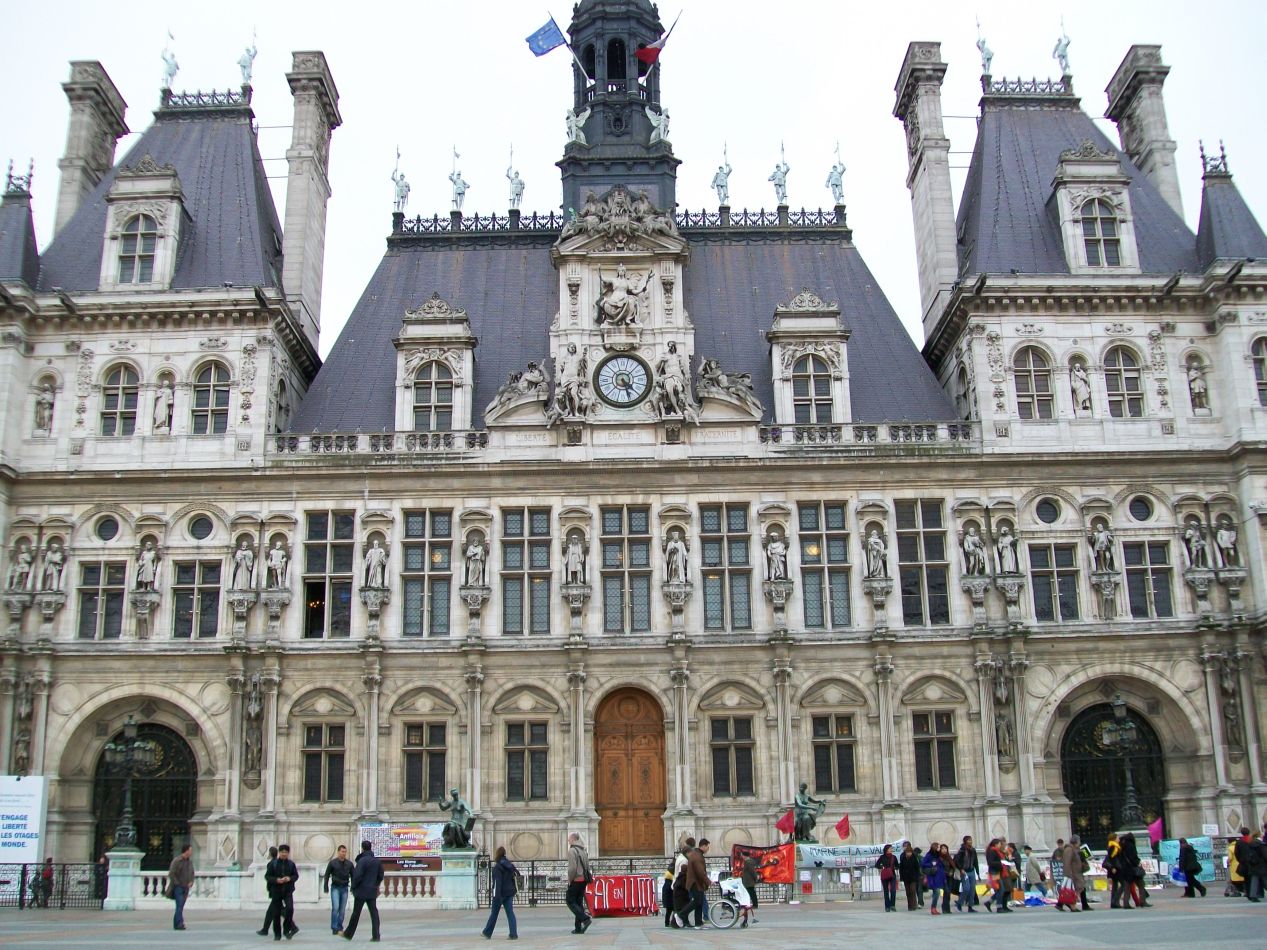


These are pictures of some Paris street scenes on and around the Île de la Cité. Most of the island is taken up with either religious cathedrals or government buildings of some type, leaving little room for restaurants or residential apartments. We crossed over to the north side of the river (the Right Bank or Rive Droite) where there was a protest of some kind taking place in front of the Hôtel de Ville, the City Hall building of Paris. Whatever cause the protesters had in mind didn't seem to attracting much attention this day. The random-looking tower standing by itself was Tour Saint-Jacques, or Saint James Tower, all that remained of the former 16th-century Church of Saint-Jacques-de-la-Boucherie. The rest of the church was torn down in the French Revolution with only the solitary 50 meter / 170 foot tower remaining. I once wrote that the city of Budapest almost had too much history due to how many different groups of people had fought over it across the centuries, and I think the same logic can apply to Paris as well.

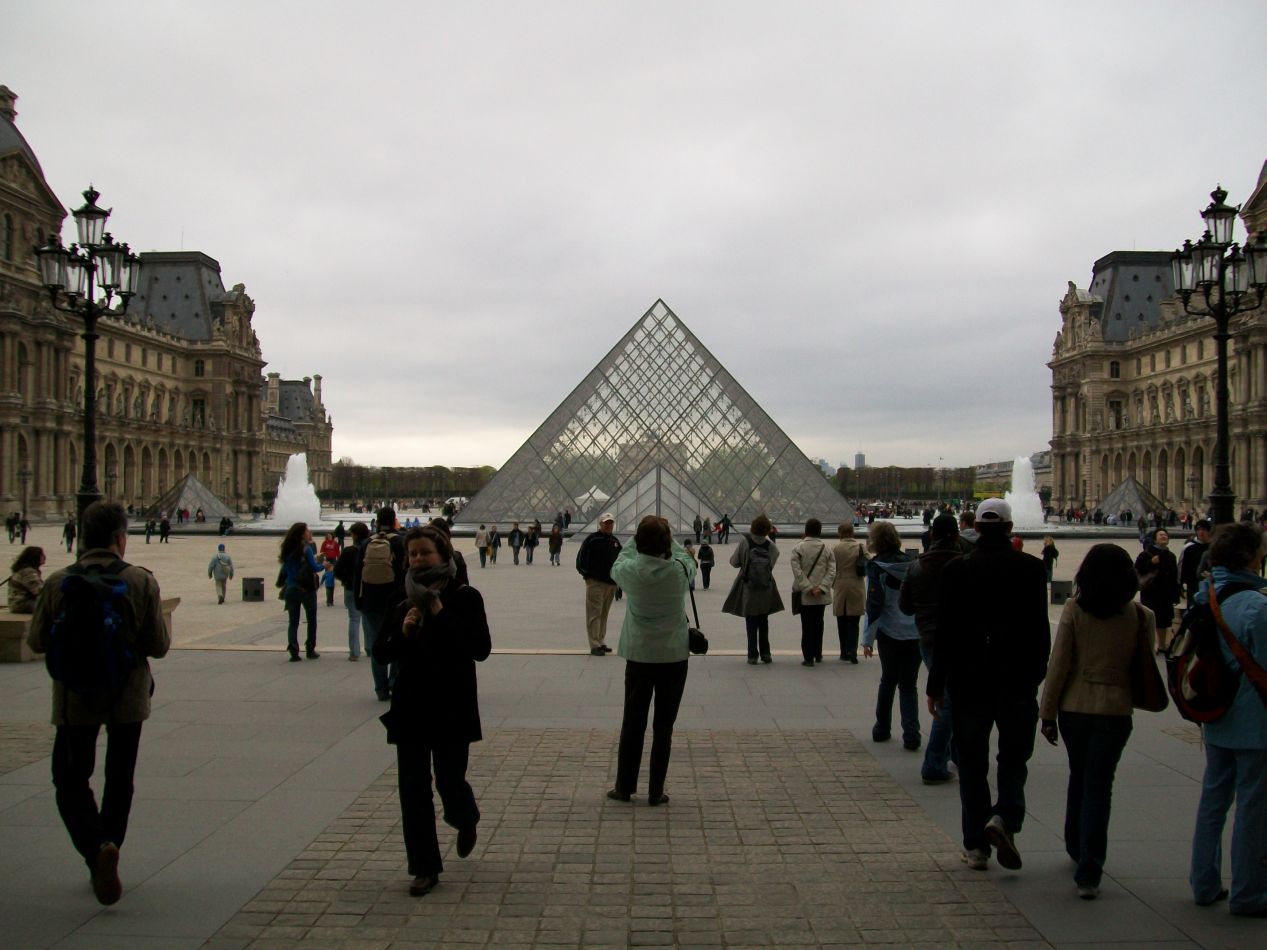


After stopping to get lunch, we headed to the Louvre for the afternoon. The Louvre is the world's largest art museum, situated in the former royal palace of France's kings, and it also draws more visitors than any other art museum at more than 10 million per year. The oldest portions of the Louvre date back to the 12th century when it was first constructed by Philip II; at that early date, the Louvre was a defensive fortification intended to protect the city of Paris from raiding Norman knights. The remnants of this initial castle can still be seen in the basement of the Louvre, and I included one such picture from that area above. The Louvre was greatly expanded again and again over the following centuries, eventually becoming a gigantic palace no longer intended for military defense and instead used for the pleasures of the French monarchs. After the French Revolution, the Louvre was converted into a public art museum and it remained such throughout the turbulent political changes of the 19th and 20th centuries. The Louvre continues to change even in the current era, most notably with the addition of the glass pyramid in 1989. The pyramid was highly controversial at the time but has become more generally accepted in the decades since it was first created. The glass pyramid is actually the main entrance into the Louvre complex; visitors walk through its doors and then descend down into an underground lobby where tickets can be purchased. The lines were fortunately not too long since we were arriving in the afternoon of a rainy day in spring.

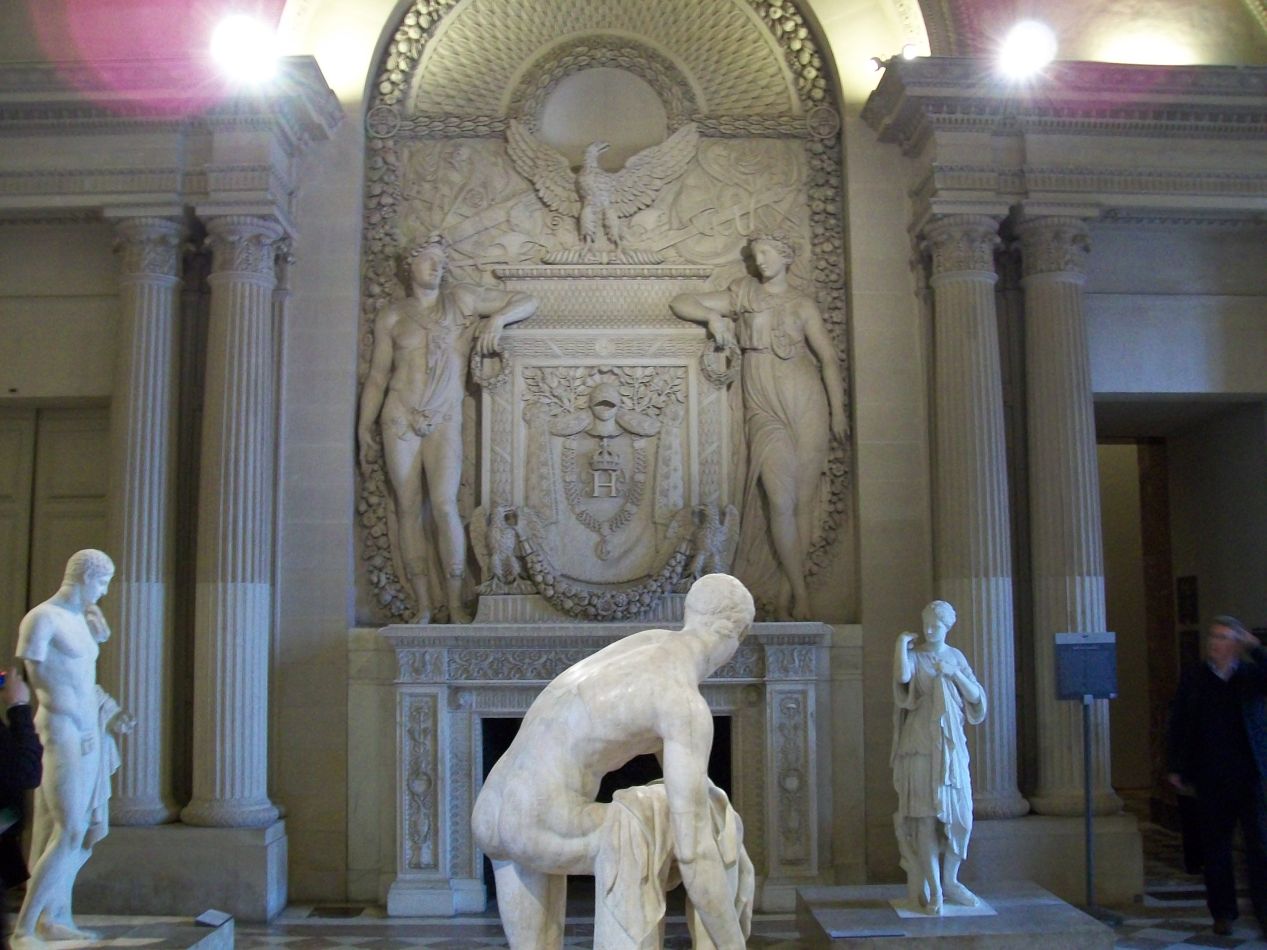


I mentioned before that the Louvre is the world's largest art museum, but that fact doesn't really sink in until visiting the place. The place is absolutely massive, with more than 780,000 square feet / 70,000 square meters of floor space in total, and it would take several days to see the entire collection on display, let alone the much larger number of items the museum holds in storage. Objects in the Louvre's collections start with ancient Mesopotamia and then run through ancient Egypt, classical Greek and Rome, Islamic art, medieval paintings, and then finally the most famous post-Renaissance art collections of the 16th, 17th, and 18th centuries. (The Louvre doesn't have much of anything dating after 1800, as these art pieces are stored in other museums in Paris like the Musée d'Orsay and the Centre Pompidou.) Much of this artwork was looted by French armies under Napoleon as they marched across Europe, and although some of those artifacts were returned in later decades, not all of them left France. Other items in the museum's collections were acquired due to the vast wealth of the French monarchy, and the post-Revolution governments of France continued the tradition of purchasing more artwork for the Louvre. The famed Venus de Milo is held at the Louvre as well as the Winged Victory of Samothrace. The most famous painting of all is also on display here:

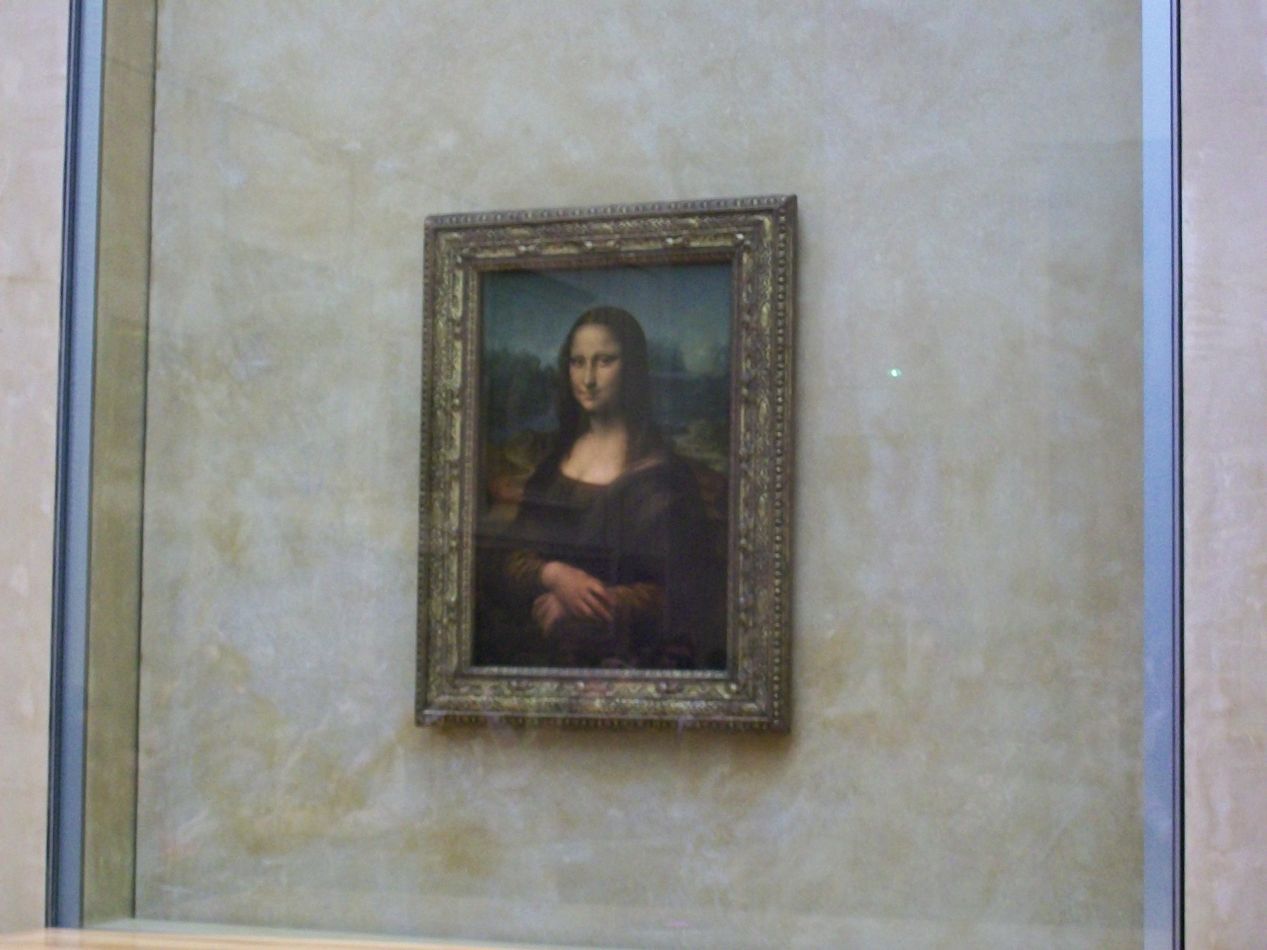


Da Vinci's Mona Lisa gets its own wall within a larger exhibition room. On both of my trips to the Louvre, this place has been packed with tourists looking to take a picture of the famous painting. The Mona Lisa turns out to be surprisingly small in person, only 30 inches × 21 inches (77 centimeters × 53 centimeters), and it does look pretty much the same as its innumerable depictions in popular culture. The Mona Lisa is not one of my personal favorite paintings. The Louvre holds all manner of other famous historical paintings, however, including a bunch that I've used for teaching purposes in the past. I've included here pictures of Eugène Delacroix's Liberty Leading the People, the perfect encapsulation of the Romanticism associated with the 1830 July Revolution in Paris, as well as Jacques-Louis David's The Coronation of Napoleon from a few decades earlier. These are both larger paintings, with David's depiction of Napoleon being truly gigantic at 20 feet x 32 feet (about 6 meters by 10 meters) in size. The figures in that painting are quite literally life-sized. We spent about three hours in the Louvre and saw maybe 25% of the artwork on display, if that. A true art lover could easily spent their whole trip in Paris just exploring this museum.

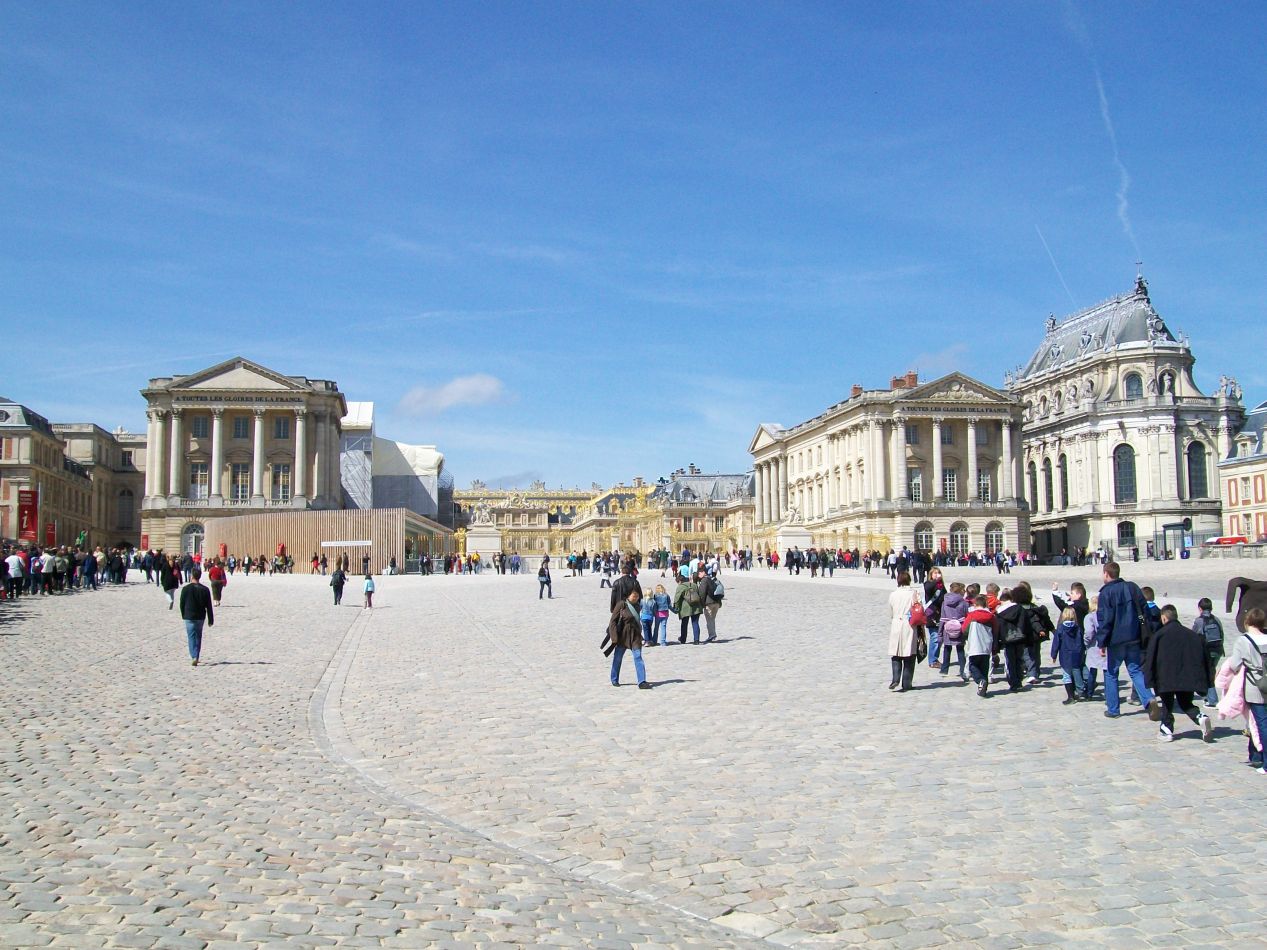


The following morning dawned bright and sunny, a welcome change from the gloomy conditions of the previous day. We were headed to the Palace of Versailles for this day's sightseeing, the former residence of the kings of France constructed at vast expense by Louis XIV. Versailles is located about 12 miles / 20 kilometers outside of the center of Paris, easily reachable by a short ride on the RER train from the downtown. This was where Louis XIV decided to turn a small hunting lodge into an enormous royal palace in the last few decades of the 17th century, eventually moving his entire court here to get away from the city. Versailles figured heavily into the events of the French Revolution, as the people of Paris repeatedly stormed the palace to secure the royal family and prevent them from fleeing the country. It was later used for the signing of major treaties following the Franco-Prussian War and again after World War I. Today Versailles is the second-most visited tourist attraction in Paris after the Louvre, with almost 8 million people coming annually. Here's a crucially important tip for anyone who might be visiting Versailles: get here early in the day right when the place opens. The lines for entry can get very long and it's easy to waste an entire day standing around outside the entrance. We arrived when Versailles was opening and only had a minimal wait for entry.

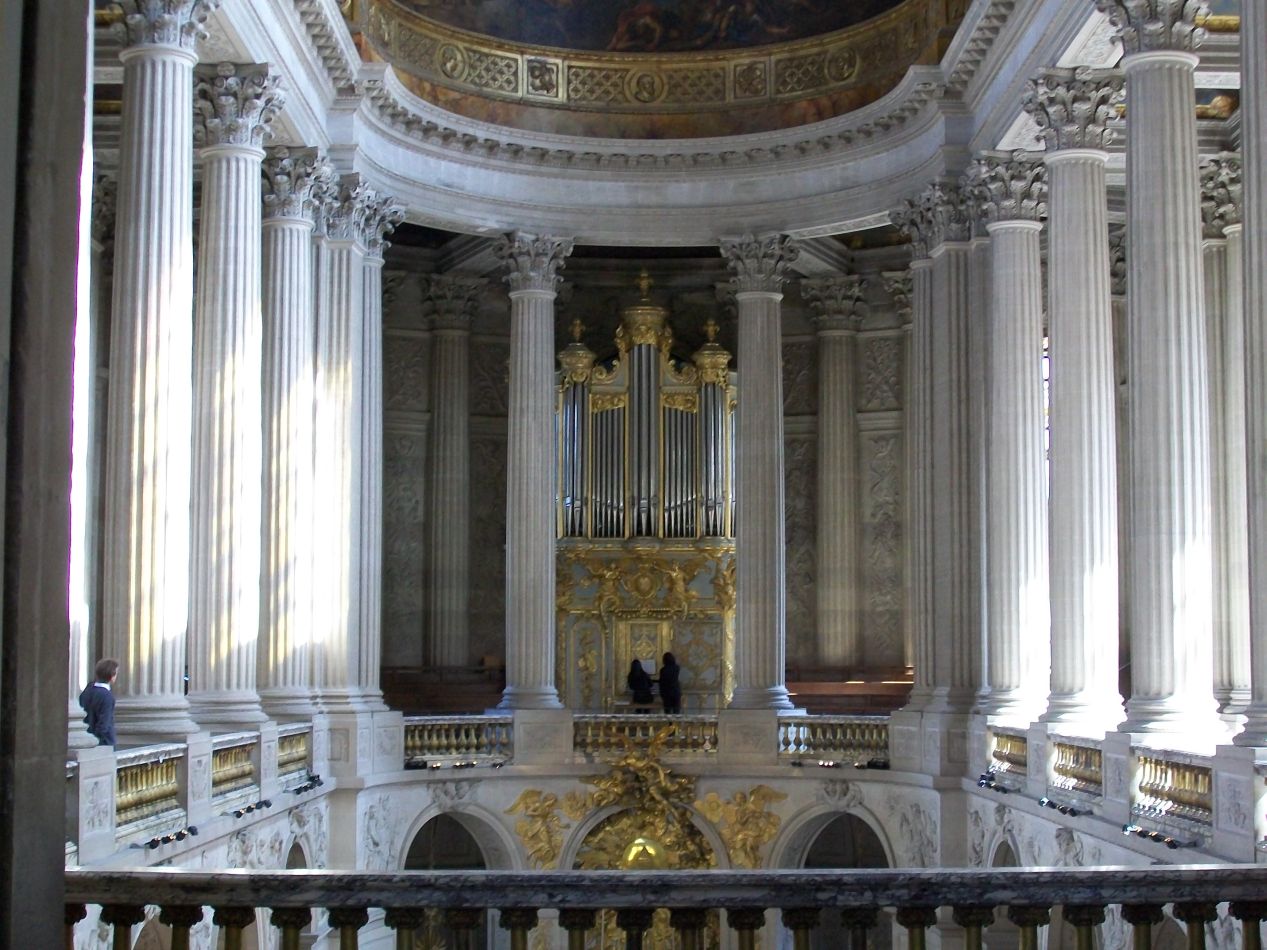


Versailles uses an audio tour for visitors, and unlike the strict rules at Vienna's Schönbrunn Palace, tourists get to see most of the Versailles complex and can freely take pictures along the way. The tour begins by taking visitors to the Versailles Chapel, which dates from 1710 and makes heavy use of marble and gold leaf designs. The use of the Greek columns indicates that this was the beginning of a transition period in architecture from the Baroque style to the Neoclassical style that came into vogue later in the 18th century. The main architectural design at Versailles is known as "Louis XIV", with the building being famous enough to get its own name since it was widely imitated elsewhere. This styling represented a fusion of Baroque Italian villas with French classical design, ending up with a result that is probably best described as "opulent". Wealth practically oozes out of every corner of the Versailles interior, whether it's the constant use of marble as a building material, the gold leaf applied to seemingly every surface, or the hand-painted ceilings in every room. It's incredible to walk through the palace and see this level of detail applied to every surface of the building.

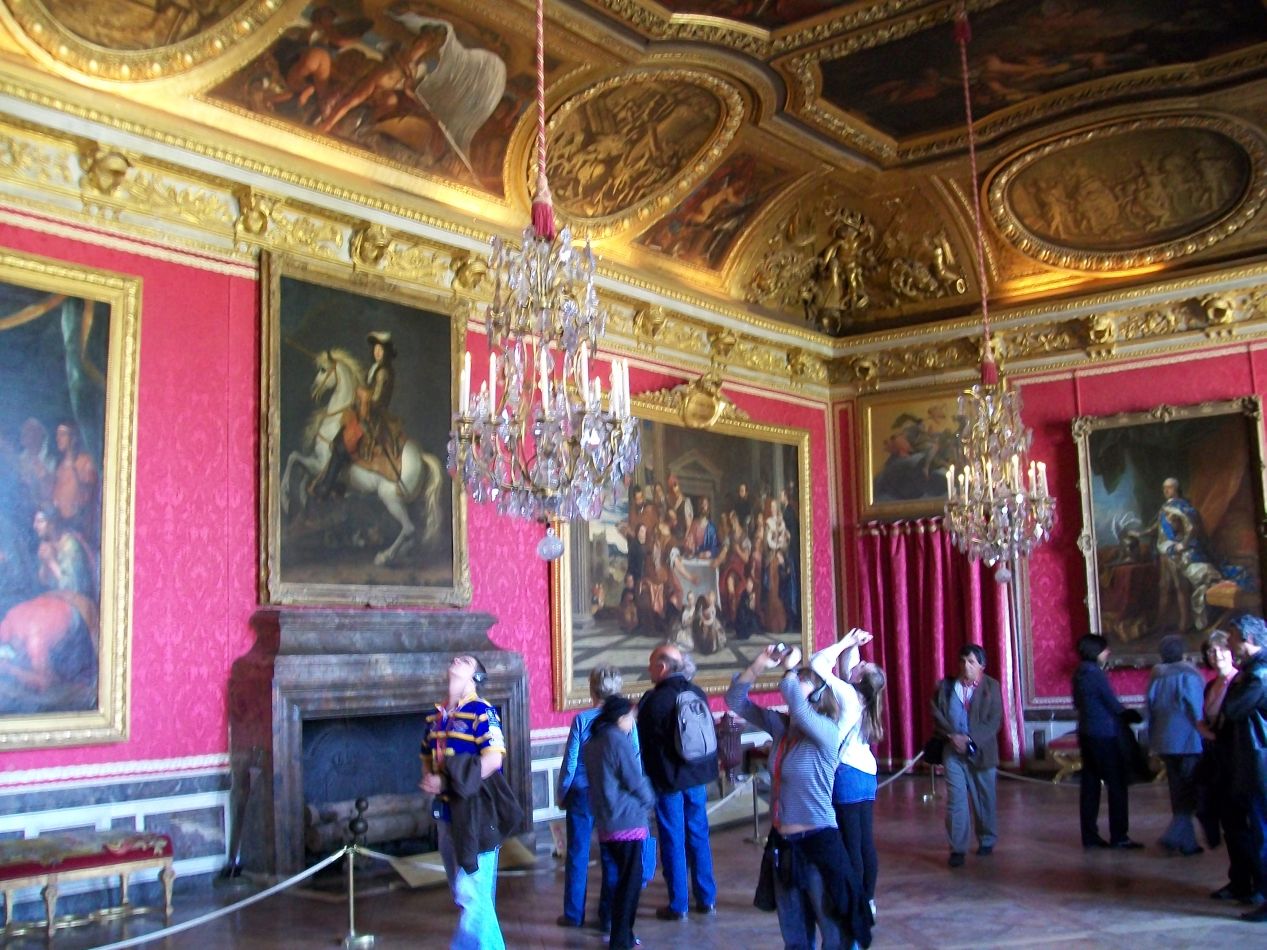


The tour leads visitors to the royal apartments where the king and queen each had their own suites. (Louis XIV was particularly infamous for entertaining a long succession of mistresses.) The royal apartments had the standard array of large paintings on the walls and absurdly overdecorated ceilings. It was easy to understand why the starving French peasants would have risen up in rebellion after seeing the excessive luxury that the royal family was enjoying. I also noticed the commonplace tiny beds also seen in colonial houses; this was due to the fact that most people slept propped up in a sitting position in the 18th century. Our modern beds would look bizarrely large to them.

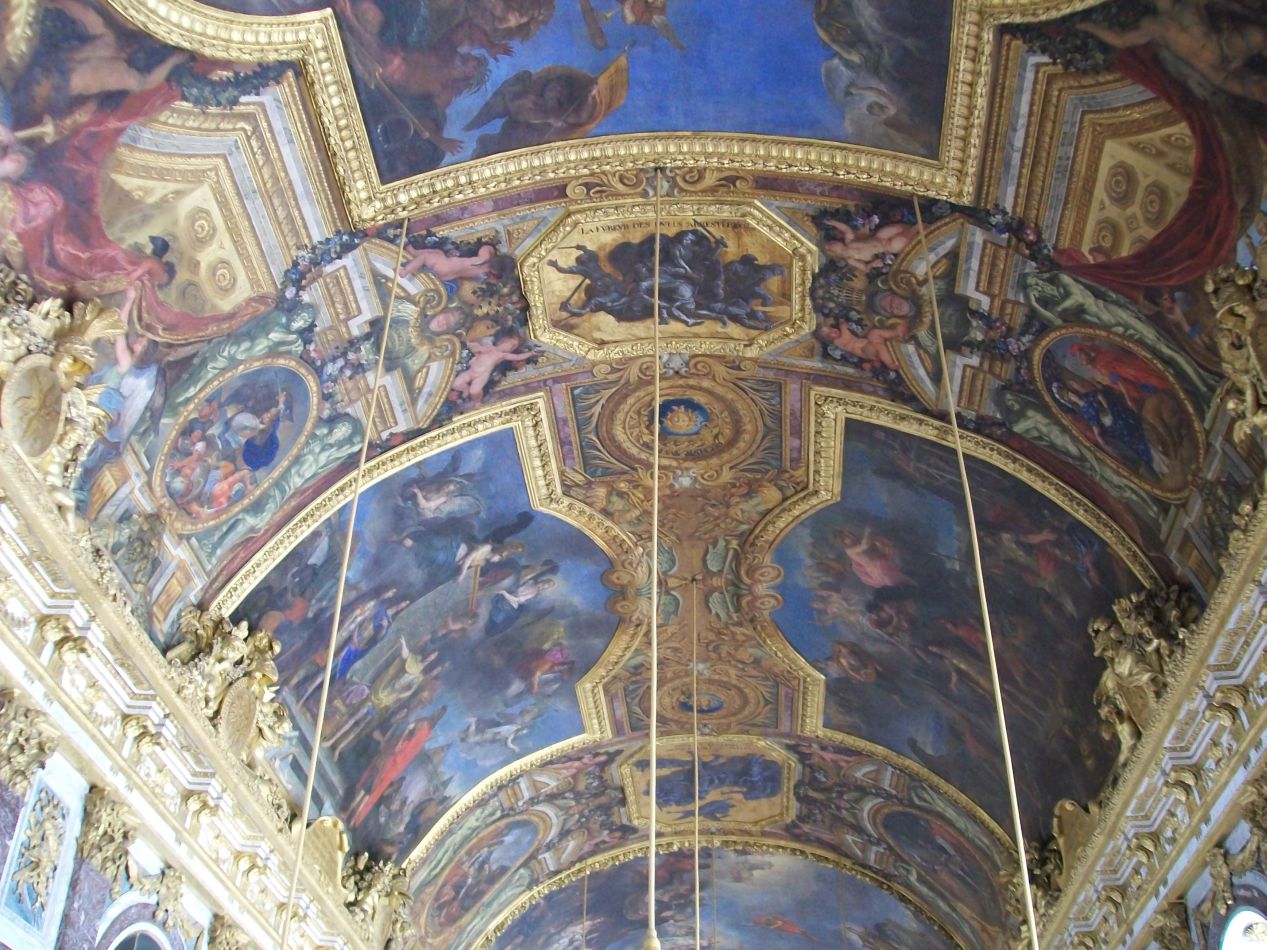


The centerpiece of Versailles is the long hallway known as the Galerie des Glaces, or Hall of Mirrors in English. This hall was used for banquets or other state functions by the French kings, and was designed around a series of arches that each contained 21 mirrors. Clear glass was difficult to produce in the 17th century and mirrors were a sign a wealth due to their high cost, making this hallway an extravagent statement of the power and wealth of the French monarchy. This same message is reflected in the motto engraved into the ceiling's central panel: Le roi gouverne par lui-même ("The king governs alone"). Louis XIV sounds like he would have been a lot of fun to hang out with, doesn't he?  The Hall of Mirrors was used for a similar symbolic purpose by the occupying Prussian army at the end of the Franco-Prussian War, as this was the spot where King Wilhelm I of Prussia was decared to be the emperor of a newly united German state in 1871. That was a deliberate gesture to humiliate the French as much as possible, and then the French turned around and repeated the same insult by forcing Germany to sign the Treaty of Versailles ending World War I in this same hall in 1919. It's almost as if France and Germany had some bad blood with each other.
The Hall of Mirrors was used for a similar symbolic purpose by the occupying Prussian army at the end of the Franco-Prussian War, as this was the spot where King Wilhelm I of Prussia was decared to be the emperor of a newly united German state in 1871. That was a deliberate gesture to humiliate the French as much as possible, and then the French turned around and repeated the same insult by forcing Germany to sign the Treaty of Versailles ending World War I in this same hall in 1919. It's almost as if France and Germany had some bad blood with each other.

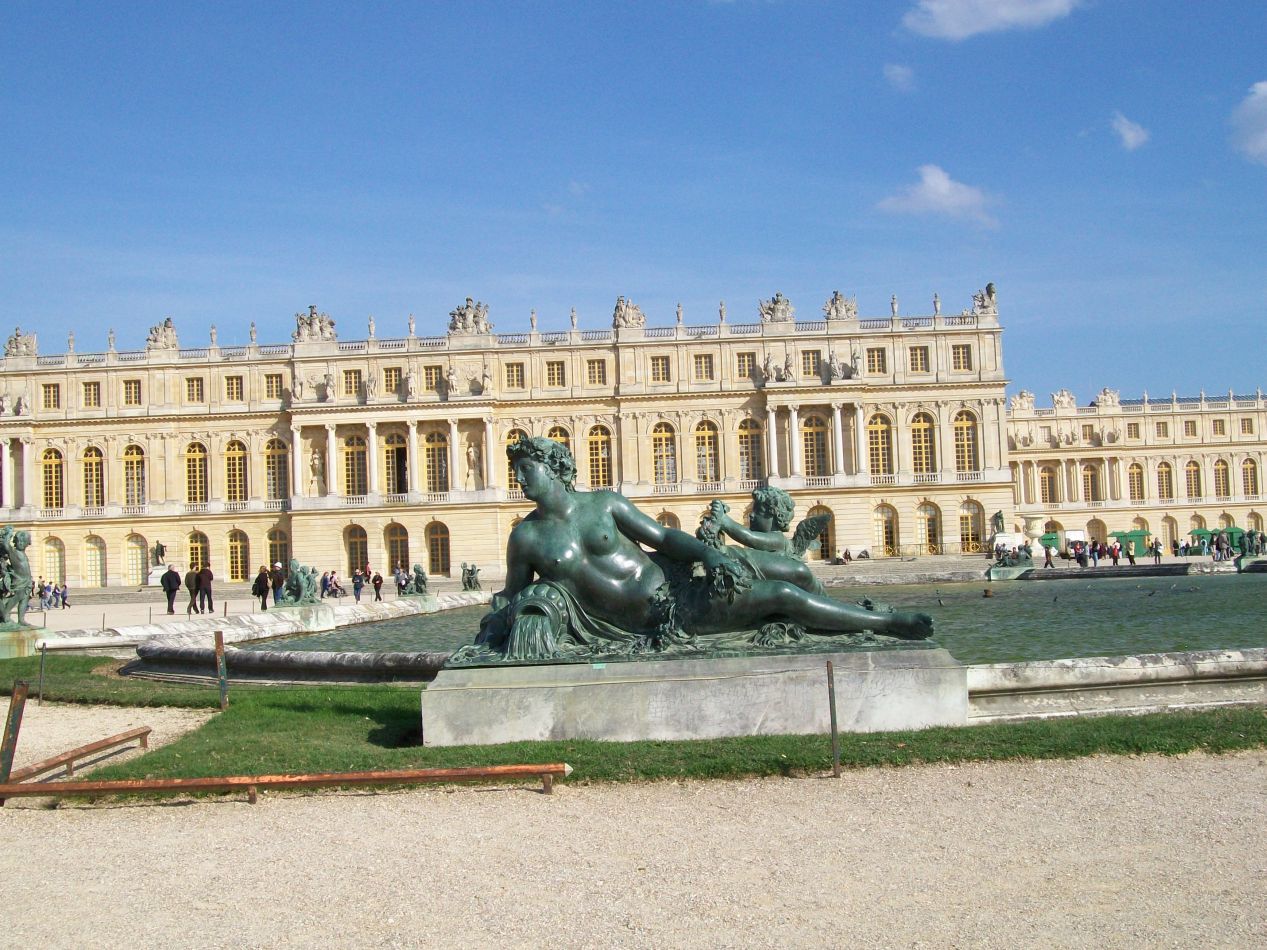


Versailles is also known for possessing a spawling series of gardens. These stretch far out into the distance behind the main palace to the smaller Palace of Trianon (which has its own extensive gardens) and Marie-Antoinette's separate apartments. There are dozens of fountains sculpted into various shapes inspired by Greek mythology and a Grand Canal big enough to launch small boats. The largest part of the garden is divided into a series of groves known as bosquets, with eight on the north side of the garden and six on the south. These groves were just in the process of blooming here in the early spring, their bare branches sprouting with new greenery. It was too bad that the fountains weren't turned on for this visit; they had been spraying water on my previous visit ten years earlier and looked spectacular. We spent about an hour walking around some of the grounds, enjoying the fine weather and exploring a few of the many walking paths on the Versailles grounds. If I visit Versailles again, I'd like to do the walk to Grand Trianon and see some of the sights over there, which I've missed on both of my visits to date.

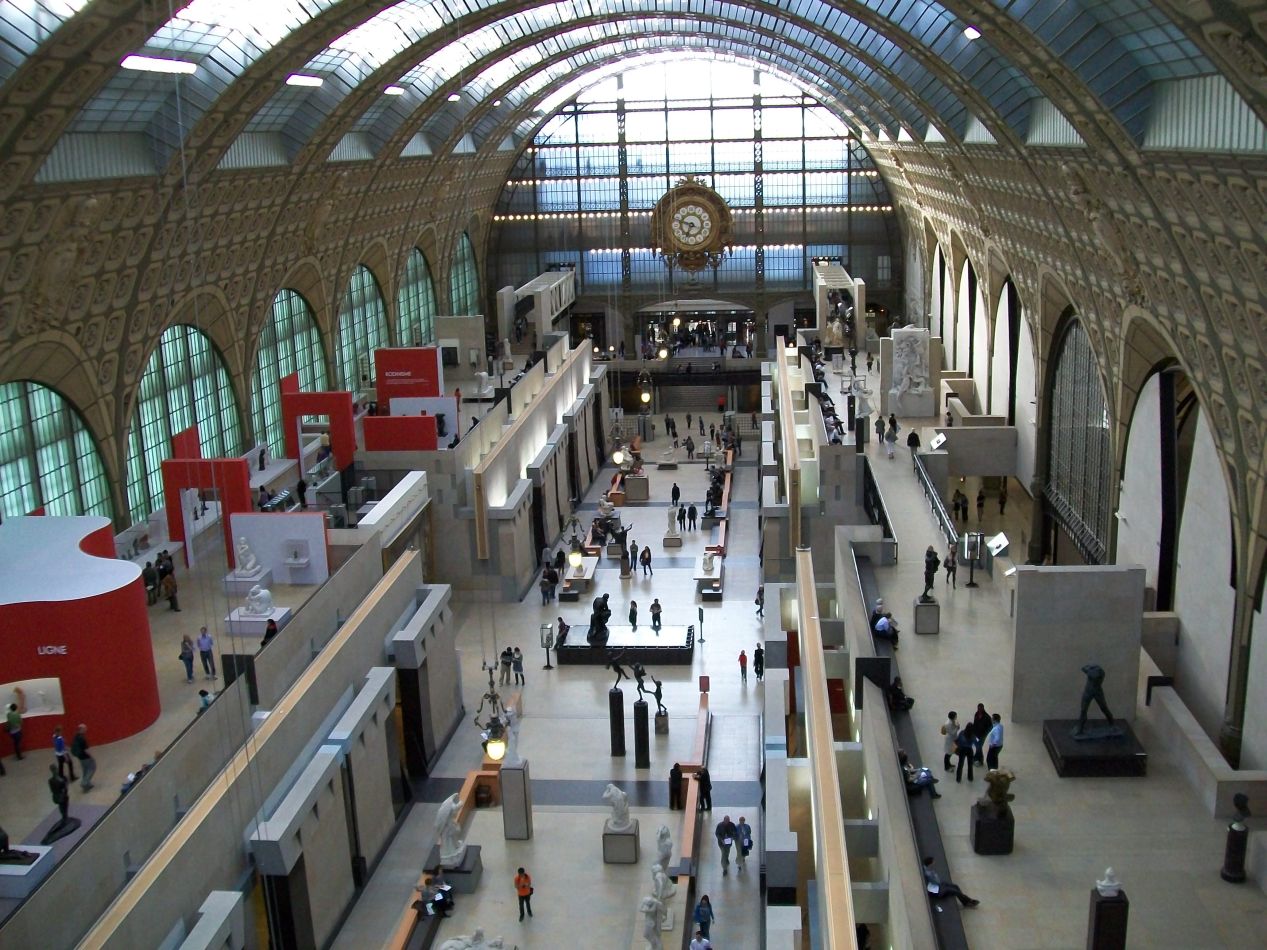


In the afternoon, we returned to Paris and visited the Musée d'Orsay. This museum is located in a former train station that has since been converted into an art museum, and it holds collections of French art dating from the period between 1848 and 1914. That largely means in practice that this is a museum of Impressionist art, the place to visit to see paintings by Monet and Renoir and Gaughin. Impressionism is one of my absolute favorite styles of artwork and visiting the Musée d'Orsay is always a treat for me. This was back at a time when I didn't take a lot of pictures in museums, and I have only the one painting by Monet (from his Houses of Parliament series) among my photos. There are 86 different paintings by Monet on display at the museum so there's no shortage of different options to see. We took a guided tour that discussed the background of a number of different pieces of famous art displayed in the museum: Édouard Manet's Olympia, James McNeill Whistler's painting Whistler's Mother, and one of Vincent van Gogh's self portraits. The Musée d'Orsay even has great views from its outdoor rooftop, such as the picture above looking across the Seine to Montmartre and Sacré-Coeur in the distance. If there's only time to visit one art museum in Paris it should be the Louvre, but the Musée d'Orsay should probably be second on that list.

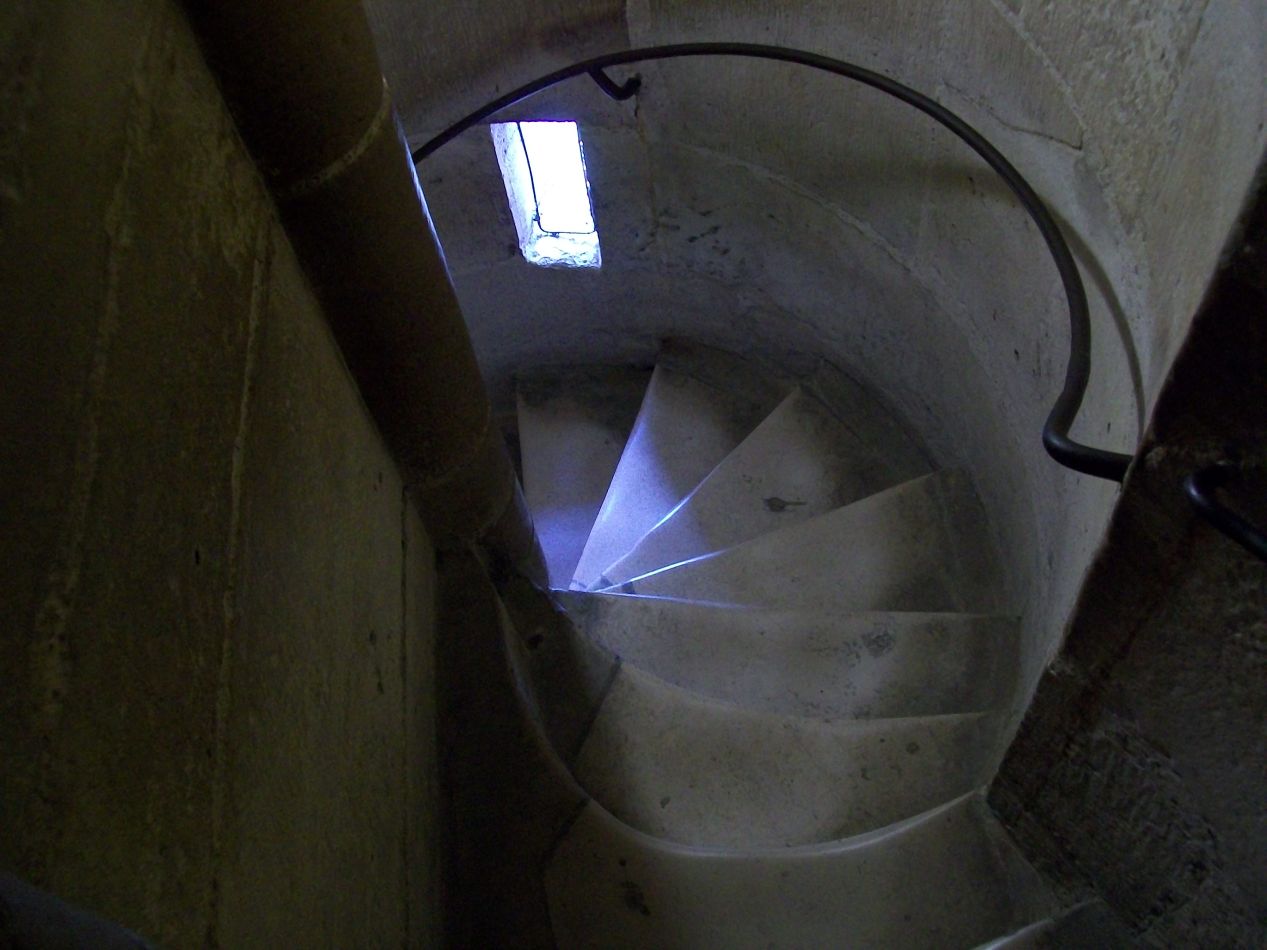


We only had one more day remaining in Paris, and really half of a day at that since we needed to take the Eurostar train back to London again. We decided to use this morning to head back to the Île de la Cité, spending some more time walking around the central island and the nearby smaller Île Saint-Louis. I wanted to return back to Notre Dame to take the rooftop tour which we had not been able to do earlier when it was raining. This required standing in line for about an hour, and I ended up reading a book that I had brought while my parents went elsewhere to explore some of the little shops in the area. Eventually I made it to the front of the line and was able to climb a narrow staircase up to the rooftop level of Notre Dame. The square in front of the cathedral was full of people down below and I was able to look out over the rest of the city at the Eiffel Tower and the nearby Louvre.

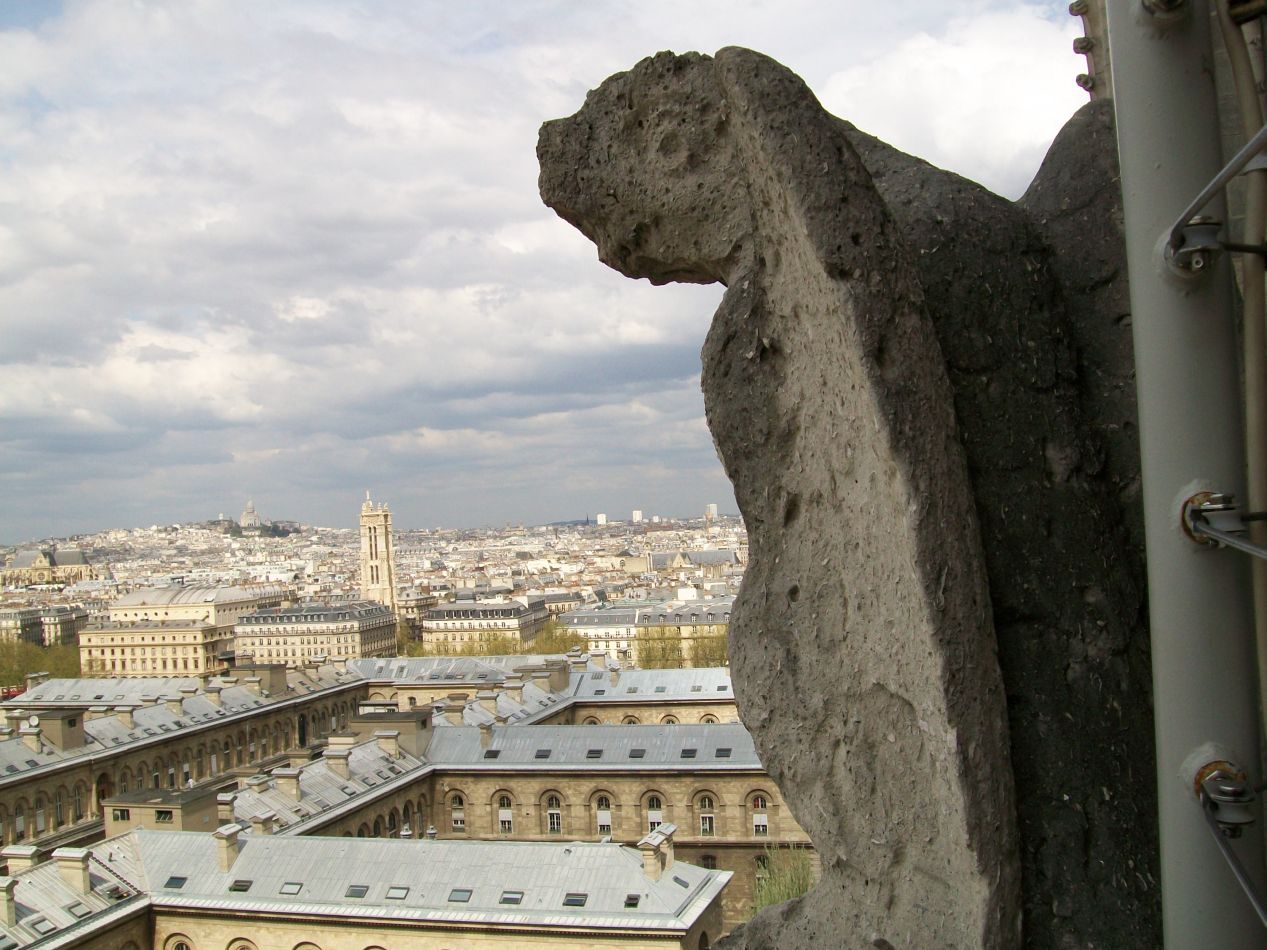


The highlight of this tour was the gargoyles located along the sides of the cathedral's roof. The gargoyles of Notre Dame have become famous enough to appear in many different works of popular culture, with perhaps the best example taking place in the Disney animated version of the Hunchback of Notre Dame from the 1990s. The monstrous shapes of these stone figures were part of the visual storybook created by medieval cathedrals, symbols of the evil and the danger that threatened those who did not follow the teachings of the church. In other words, they were part of the same narrative as the stone figures of saints and other Biblical figures, passing along a religious message to a population that was almost completely illiterate. The gargoyles at Notre Dame also had a secondary function: they served as the rainspouts for the cathedral, and still drain the water that runs off the roof to this day. A close inspection of the gargoyles that projected out from the walls revealed clear channels for rainwater to run through, making them both fanciful and functional at the same time.

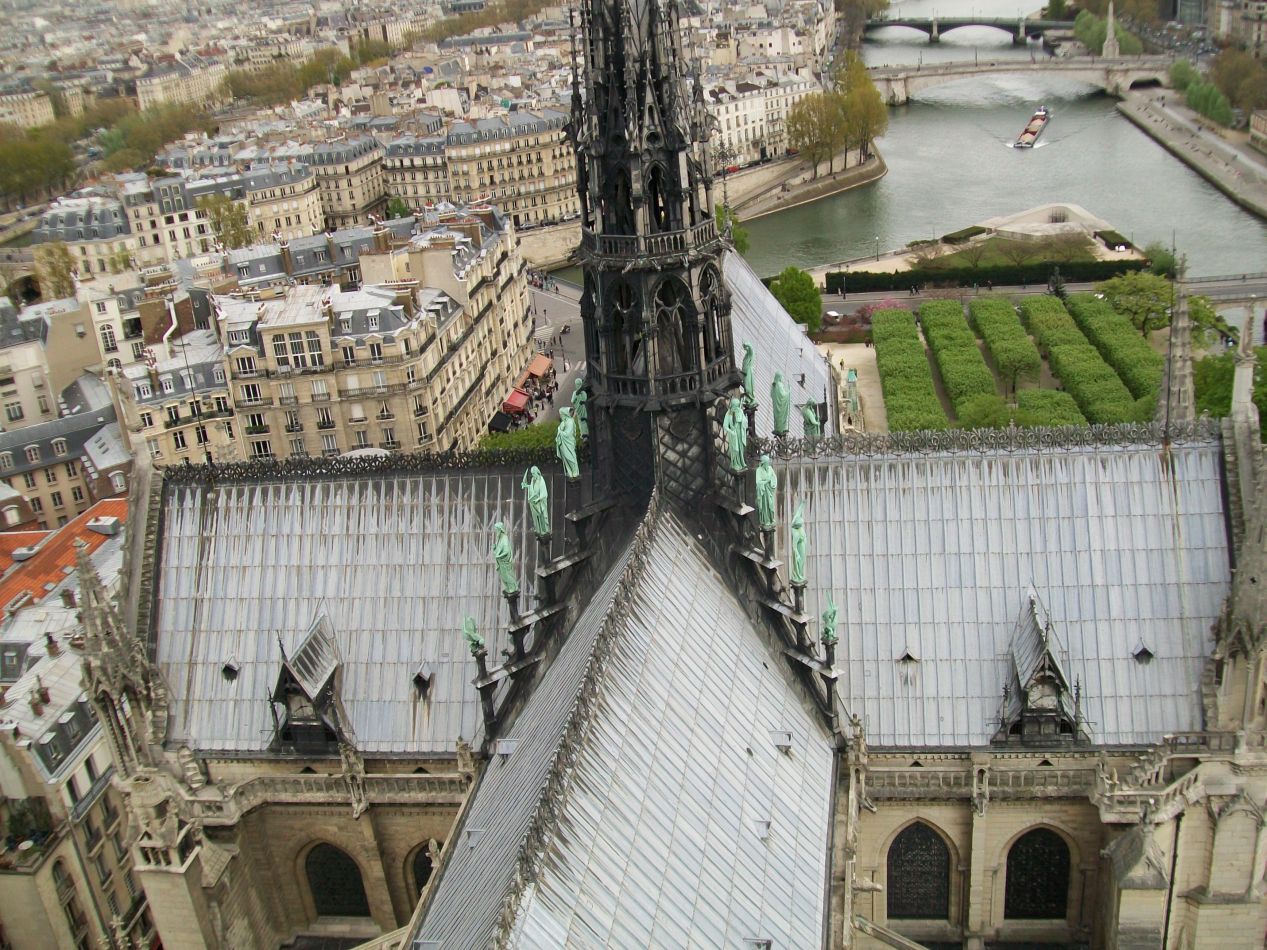


The rooftop tour of the cathedral also took visitors into the bell tower of Notre Dame, the place where the mythical Quasimodo supposedly rang the giant bells each day. There are almost two dozen of these bells in total, with the largest one (named Emmanuel) weighing 13 tons and dating back to the medieval period. Most of the others were destroyed in the French Revolution and have been replaced with modern versions. The belltower had an entirely wooden interior and was highly interesting to visit, but unfortunately it was too dark inside for any of my pictures to turn out clearly on this cheap digital camera. The tour also provided views of the cathedral's rooftop and spire, and these are unfortunately parts of Notre Dame that can't be viewed any longer. A massive fire broke out in the cathedral on 15 April 2019, almost exactly ten years to the day after these pictures were taken, and the roof and spire were both completely destroyed. Everyone was terrified that the whole cathedral would be lost, but fortunately the exterior walls held up and the damage was limited to the roof. The copper statues on the spire had even been removed before the fire as part of a renovation project and were also safely preserved. Reconstruction is underway as I write this report and it won't be long before Notre Dame is restored back to its former glory once again. I am exceedingly glad that the world did not lose this priceless treasure.

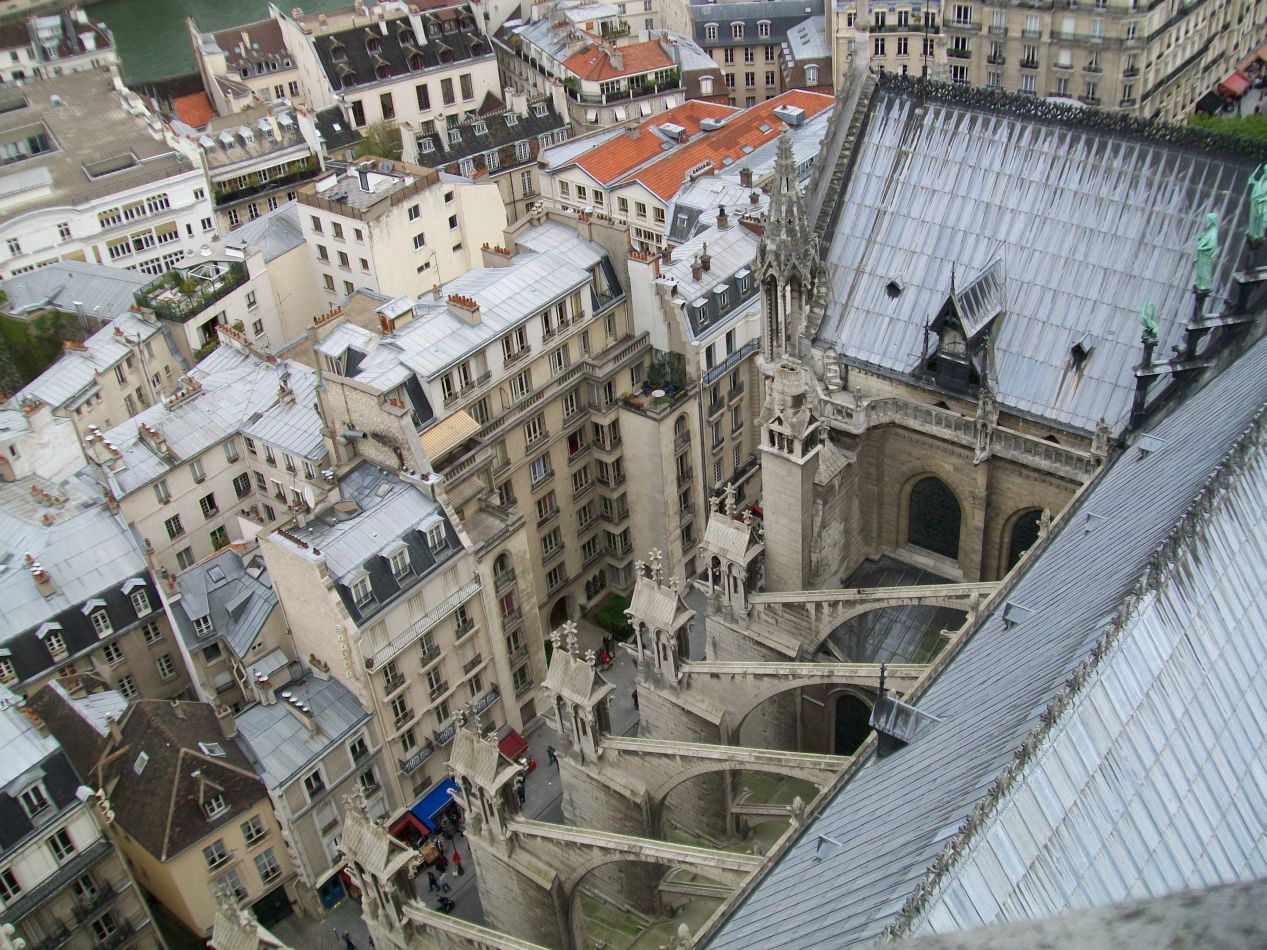


I'll wrap up this report with a few more pictures looking out at the rest of the city from the rooftop of Notre Dame. We had a wonderful time on this trip, with excellent weather on all but one day and much smaller crowds than we would have seen at the height of the tourist season in the summer. I was happy to be able to take my parents to visit some of my favorite sights in the city of Paris and serve as a translator of sorts when needed (which was almost never since everyone in Paris speaks English). This is truly one of my favorite cities in the world, and I want to come back again for a third visit with my wife Liz. There are still a whole lot of places in the city that I haven't seen on either of my trips: the Panthéon, the royal vaults at Saint-Denis, the catacombs under the city, the Centre Pompidou, the parkland in the Bois de Boulogne, and so much more. Paris is one of the most visited cities in the world and it's easy to see why. I'm sure that I'll be back again someday at another stage in my life.



